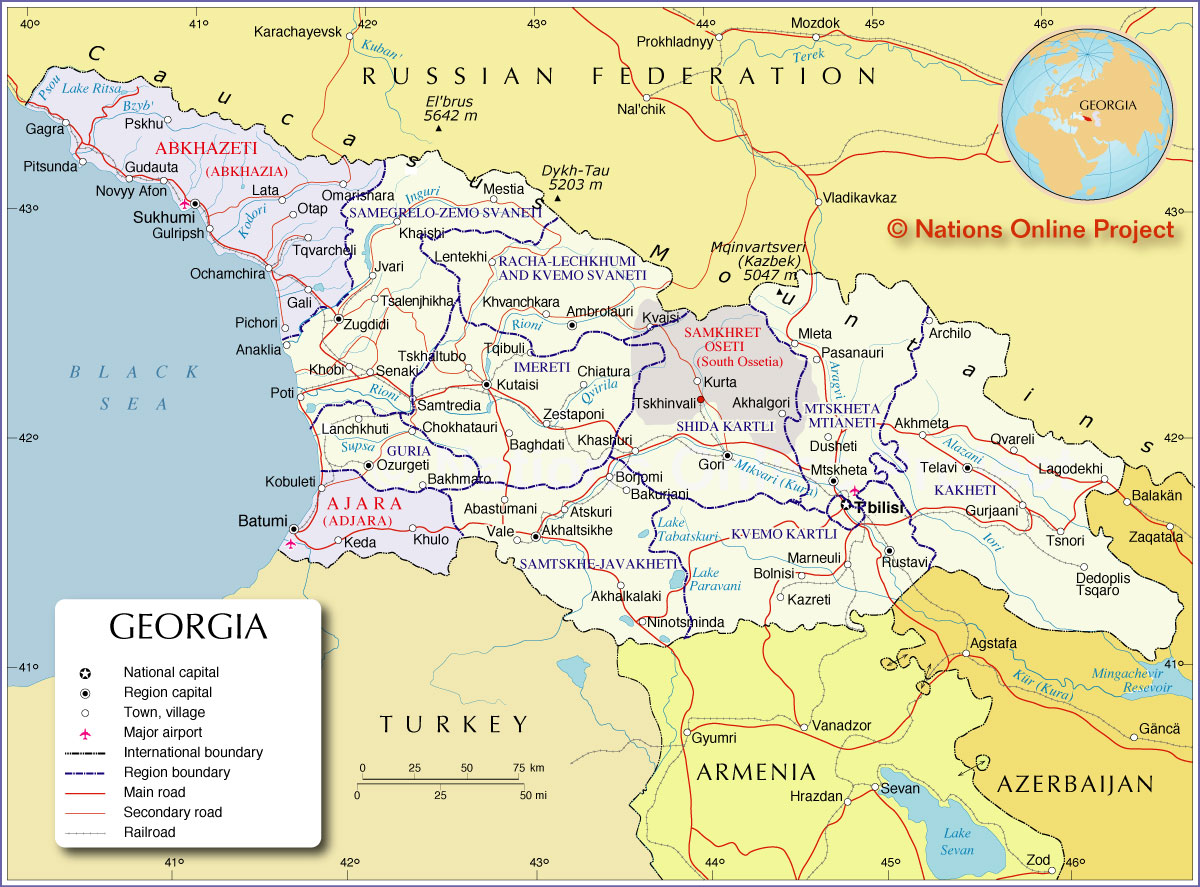
20 October - 6 November
Complete

I welcome feedback on this blog. Please write to Stephanie
Pre-Day 1
Getting excited as I now have the potential packing laid out on the spare bed - trying to be minimal, and anticipating the layered look. I have lots of reading material on Georgia and catching up. The flight leaves Humberside at 6am, so this involves leaving here at 4am (not looking forward to that part) but once on the way the journey is eight and three quarter hours with a stopover in Amsterdam (always a pleasant airport). I should be with Beth in Tbilisi around 5:15 in the evening her time. The time difference is +3 hours.
Day 1 Wednesday 20th October 2010
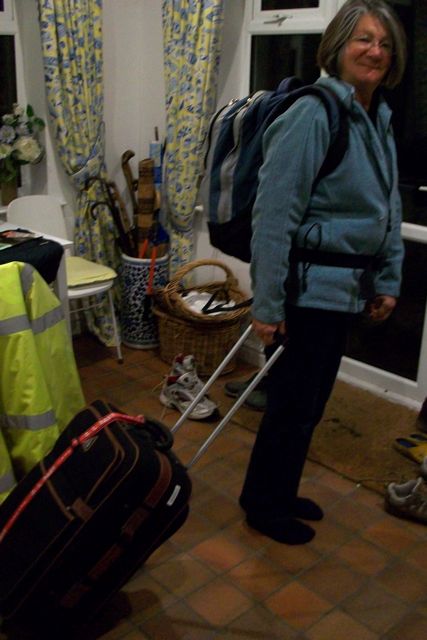
Not at my best at 4am, but travelling light
Humberside is a great airport to leave from! I had checked in on line the night before, and you need less than an hour before departure - it is one of the smallest airports in the UK. Still dark as we flew over Sutton-on-Sea, and within 45 minutes we were in Amsterdam. Schiphol is a pleasant airport for a couple of hours, and I was eagerly waiting at the gate for my Georgian Airways flight to Tblisi. Small plane, not full (I had three seats to myself) - how nice to have no trappings like tv and films, and just to be able to read - felt good. The flight was only 4 hours and 15 minutes, and after about three hours the snow capped Caucasus emerged above the clouds - what a thrill. I identified Mt Elbrus (5642m) the highest mountain, then Mt Shakara (3200m) - we will be close to both of these when we go up to the Svaneti region leaving on Saturday. The next one is Mt Kazbek (5047m), and last Mt Diklos (4285m) I wonder if they are permanently snowcapped?
We circled down to Tbilisi on the southern edge of the mountain range - a small ancient city on the Silk Route, with an airport not much larger than Humberside!! A warm welcome from the Georgian immigration, and an even warmer one from Beth - I was through in about 20 minutes from landing.
Beth had her driver with her, who whisked us off the half hour to downtown. It was sunny and 23 degrees. The roads not too crowded even though it was rush hour, and I got some first impressions of the architecture - churches visible on the hillsides, villas like in Van in Eastern Turkey, the low rise Russian drab looking apartments, then the tree lined streets as we got to the older areas - Autumn approaching as these trees are turning yellow. The entrance to Beth's apartment is very unprepossessing, and the shared hallways drab and old, but once entering the fourth floor apartment, another world of high ceilings and large old fashioned rooms, all with chandeliers.
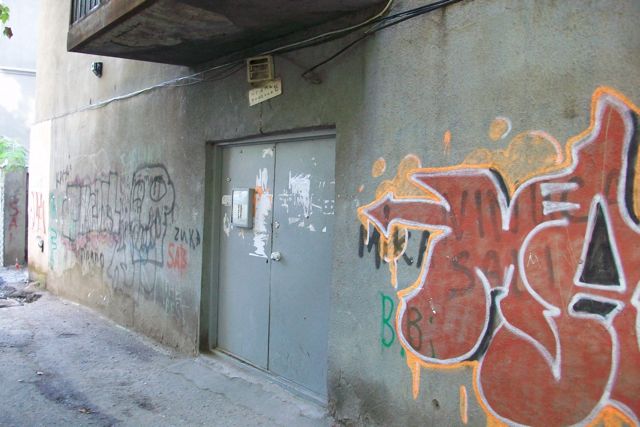
Unprepossessing entrance!
We were soon out discovering the local neighbourhood in the gloaming! Old fashioned everywhere, holes in pavements, dim lighting, and then bright shiny modern shops amid the old local stores. We wandered enough for me to get my bearings, find the bus stops etc, then went to a local restaurant for a simple supper before buying breakfast croissant and back - I was a bit jet lagged because of the early morning start, but found my sofa very comfortable by 10 pm. So excited to be here.
Day 2 Thursday 21st October
A morning of adjustment - woke at local time of 8:38 am (5:38 on my internal clock). Beth had already left for work, so I made a coffee, and gradually got going, establishing an ethernet connection with help from John via Beth's computer. By the time I had sorted out, showered and prepared maps for the day's explorations it was 11 am.
Autumn, warm and sunny greeted me as I emerged into the street, and avoiding potholes headed down to the main road, where I was greeted by a warm Hello Stephanie and a kiss from Temori, Beth's driver. A lovely start to my day exploring the ancient city of Tblisi on foot. It took me about an hour to walk down the tree lined streets passing Universities and promenaders (people here don't walk, they stroll!) to get to the beginning of my walk around the traditional areas.
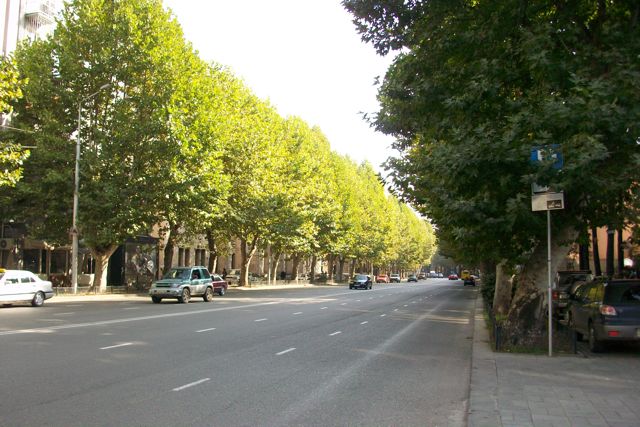
Tree-lined main road
I stopped to gather strength and information over a coffee in a courtyard at Prospero's Books. I was walking down Rustaveli Street, which is the main artery where all the elegant and important buildings are located, including the cultural and arts buildings. The statue below is of the 12th century poet Shota Rustaveli, whose poetry is still recited by every Georgian child today according to Beth.
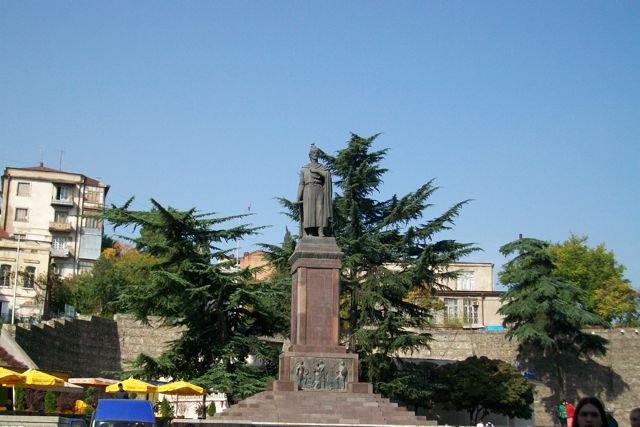
In fact there were amazing sculptures everywhere, and I need to find out more about these. I do know that in the alliance with Russia from the early 19th century it was a haunt of writers such as Pushkin, Tolstoy, and even Tchaikovsky and Alexander Dumas came here, possibly because it was a half European and half Asian city, with wonderful sulphur baths. The word Tbilisi means warm in Georgian, and the city developed around the hot springs from the 4th century. The Narikala Fortress, which was one of my destinations today, welcomed travellers. Indeed it did on the Silk Road, when traders passed this way.
I made my way onwards past the parliament buildings towards Tavisuplebis moedani (Freedom Square) - this has the city hall on one side and was Lenin Square in Soviet times. Georgia's last Lenin statue toppled in 1990, stood where the golden St George now spears his dragon.
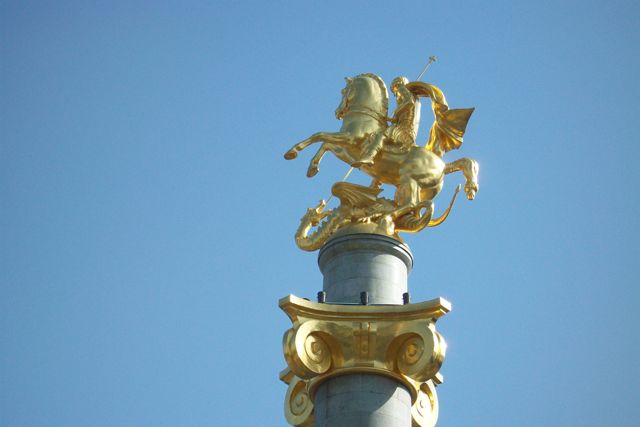
From here I wandered and got totally lost in the very old area of Tblisi, with rundown houses with precarious wooden balconies hanging over the streets and rusty pipes overhead taking the water from courtyard to courtyard. This area was fully lived in, as it has been for the past 300 years, the area developing below the fortress and near the river gorge below
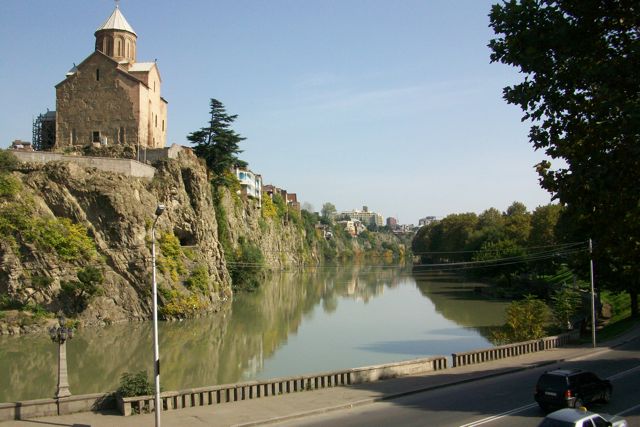
River Mtkvari Gorge below the old town
I emerged at the Sioni Cathedral, where I sat next to a small group singing Georgian songs in the shady courtyard before heading for the bathing area of Abanotubani, where the sulphur baths are - all you see are the beehive domes above ground. Beth and I are planning a visit when we return from our adventures in Svaneti.
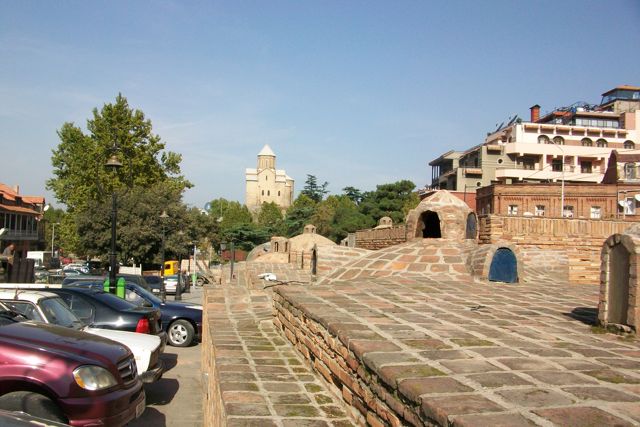
Beehive domes of subterranean sulphur baths
Following some ladies I climbed hidden steps to another level above the baths and found the entrance to the Botanical Gardens (cost 1 lara = 30p) This was a huge haven of peace, opened in 1845 in what had been royal gardens below the Narikala fortress. I wandered for an hour or so, and just sat in the shade enjoying the peace. It was obviously a place for young lovers to come, and I met a couple of elderly ladies, one who came up and hugged me, then realised I wasn't who she thought I was - a really warming encounter - lots of smiling ensued.
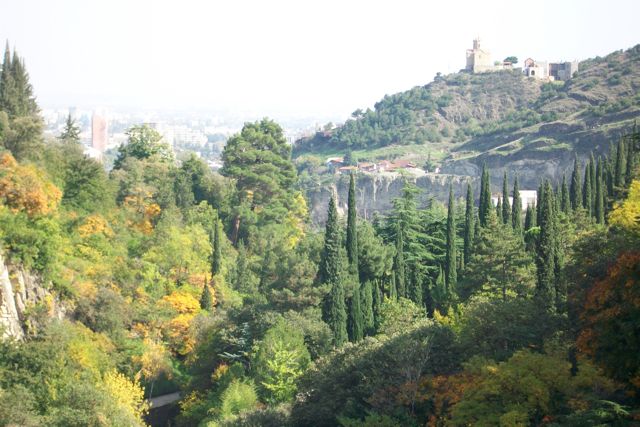
View in the botanical gardens
From here I could also see a skyline feature of Tbilisi, Kartlis Deda - Mother Georgia, a 20m aluminium statue with a sword in one hand and a cup in the other - the metaphor for the Georgian character, warm and welcoming guests, passionately fighting off enemies!
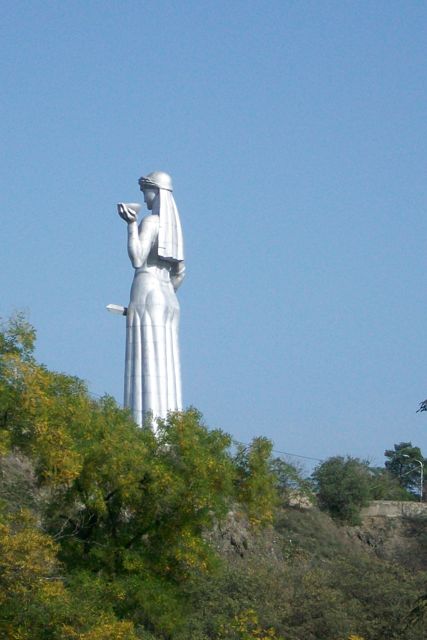
Kartlis Deda
The other view was of the Narikala Fortress, which held a strategic position from the 4th Century when it was a Persian citadel, but since has been built, rebuilt and occupied by Arabs, Georgians, Turks and Russians. As i panted the last part up the hill, a wedding was taking place at the Church of St Nicholas within the fortress.
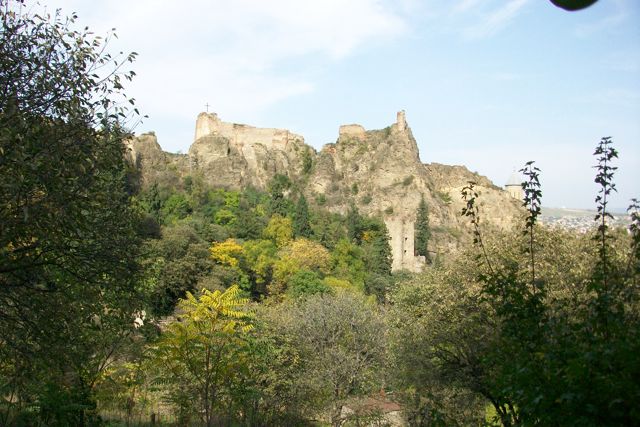
Narikala Fortress from the Botanical Garden
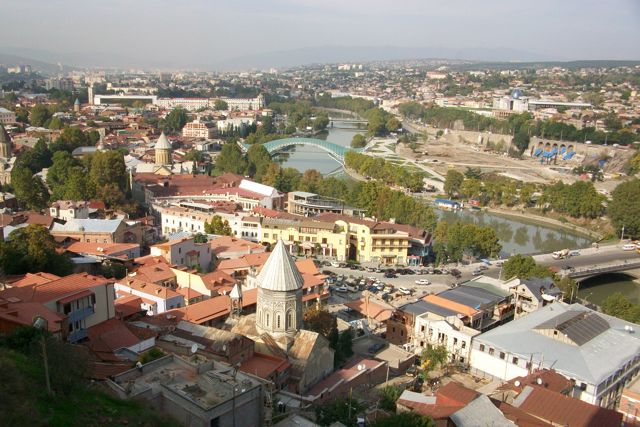
View from Narikala Fortress of Old Tbilisi and beyond
By the time I had descended through more construction and rubble to street level, I was feeling a little foot sore and hungry (it was 3:30pm and I had been walking since 11am) I thought I would finish the day in the Tbilisi History Museum, but auspiciously it was closed. I headed back through the old area and found a queue at a small bakery waiting for the Khachapuri (cheese filled pastry) to come out of the oven. I joined the queue and had an instant snack for 90gel (25 pence). Sitting in a square to eat this I noticed I was outside a tourist information, where I found out the nearest place to catch the number 61 bus. It was very close by, so I sat in the shade waiting for the bus to come.
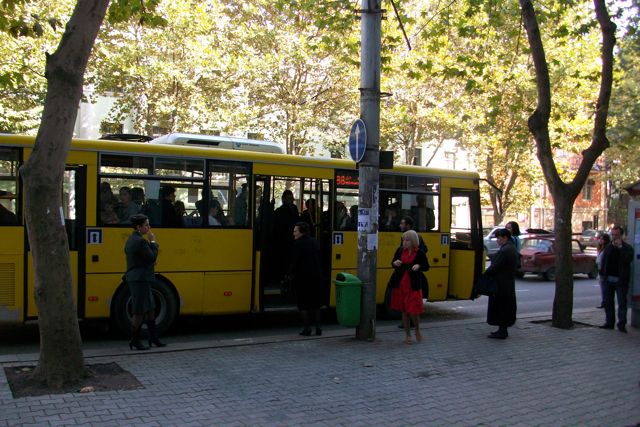
Many other yellow buses passed by!
Mine did come, and with help I figured out the ticket system, then anxiously looked for familiar signs. It took about 20 minutes to get to the University area, then I looked out for a pink building, and indeed got off at the right spot.
Exhausted but exhilarated by my first day in Tbilisi. Beth came home around 6pm, and we caught up over dinner before she had to leave for Georgian singing. I downloaded photos and started the blog before collapsing onto the sofa. Rain in the night.
Day 3 Friday 22nd October
Another steady start to the day, catching up before leaving for a day hiking! I wore hiking boots, which was essential after last night's torrential rain, both for the pavements, and later some very muddy, steep trails. I was following a walk described in 'Walking in the Caucasus' by Peter Nasmyth, which began in Vake Park, a ten minute walk from here, and took me up to a lake in the mountains, and even a little higher to 800m before descending to an ethnographic park, and back down to Vake Park again. By the time I got going it was sunny and warm again, just muddy underfoot.
Vake Park was formerly the Soviet's Victory Park, and is dominated on the hillside by an enormous black Lady Victory Statue (28 m high), which is at the top of a very steep waterfall (not working). The climb to the statue alone involved numerous uneven steps! Alas sadly, in public places, there is a lot of rubbish everywhere - especially plastic bottles
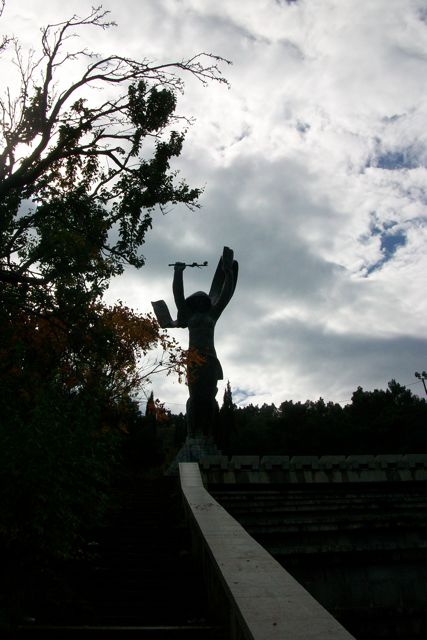
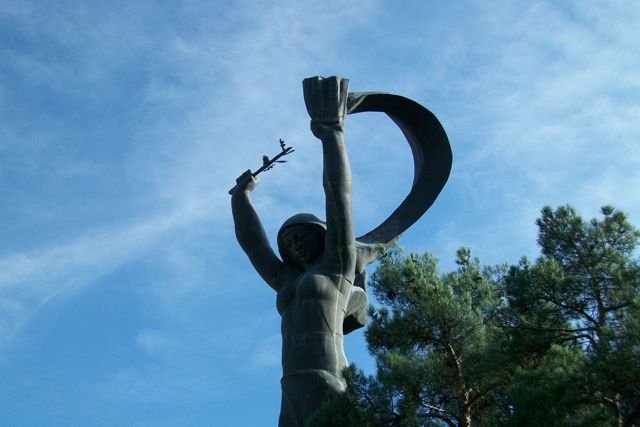
Behind the statue my instructions were to head up any of the trails, occasionally seeing signs of the old cable car which spasmodically runs up. This was a steep and slippery slope, but I took my time and enjoyed the autumn leaves.
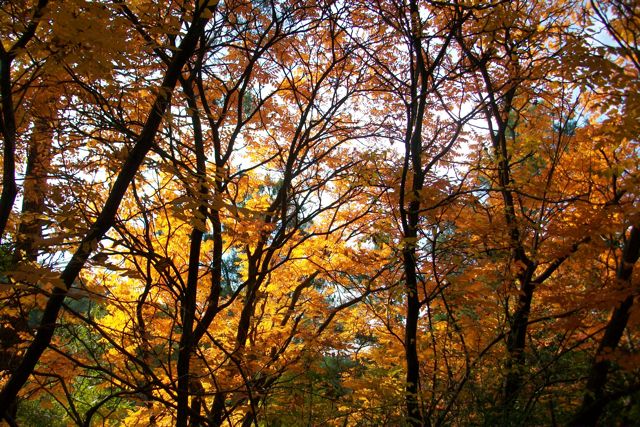
I finally reached the destination of Kus Tba, or Turtle Lake, which is a summer resort for swimming and relaxing.
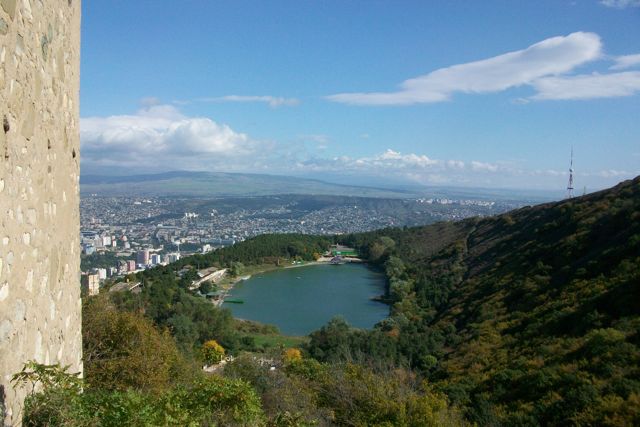
I took a brief rest, and then climbed up to a Svan Tower, from where this was taken (I have to say I did not meet a soul on this entire trail, but I did see many wild autumn crocus)
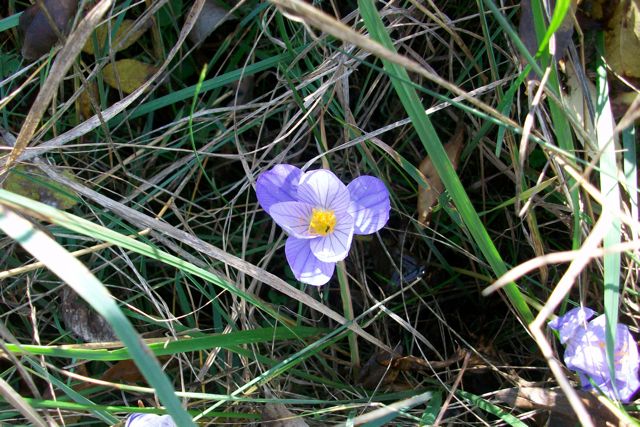
There were also mushrooms - my eyes are becoming attuned after a couple of fungus forays in Lincolnshire last weekend! The Svan Tower was just a tempter for the real ones I will be seeing in Svaneti, and this one had been brought stone by stone from that region. From here my trail was down all the way, first stopping at the Open-Air Museum of Ethnography. This was a real treat for me - the setting is over an unspoiled hillside, and there are 70 traditional houses brought from all the regions of Georgia. They can all be viewed, and several have been furnished authentically - I just love this sort of thing, and had a good wander around, encountering a couple of elementary school excursions, a university small group with their lecturer, and a small group of foreigners with a very stern looking type of intourist guide I encountered in the 1970's in Russia and Central Asia! It was lovely to just wander at will.
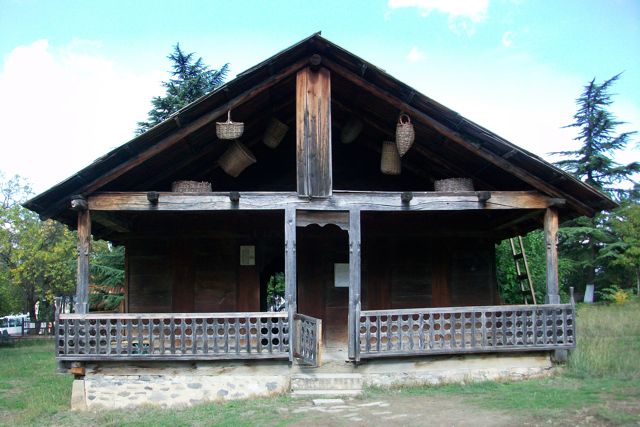
18th Century House from Sajalabo saghla, Abasha region
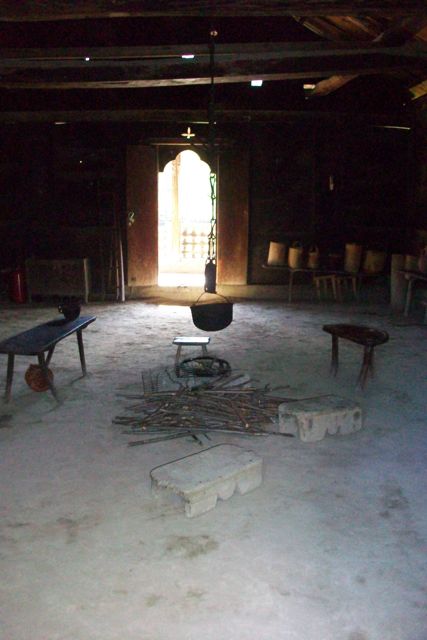
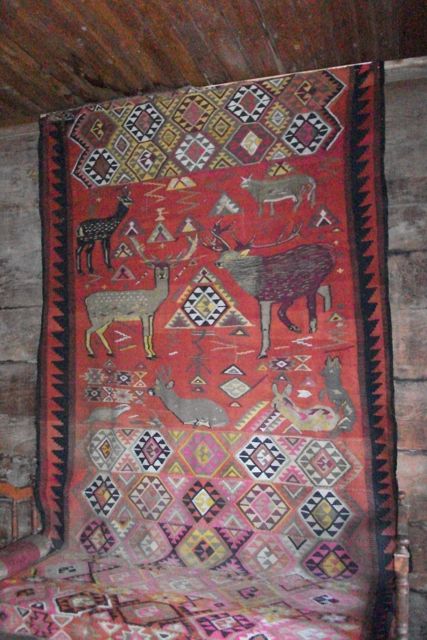
The kilim seemed very familiar from ones bought many years ago in Turkey - I think I need to get them out of the roof space and revisit them when I get home! I may have seen a Hoopoe today (first encountered in India 1975), I certainly saw a beautiful yellow butterfly, some scabious (I remember that was from the Caucasus), and even some wild aster, as well as the lovely Autumn colour. It seemed a shame to descend back to the city, but my stomach was rumbling, and I bought another kind of pastry with mushrooms and chicken to have with coffee on my return.
The next part was written during our adventures in Svaneti when we had no internet. We had a wonderful trip to the wilderness area of Georgia as you will read and see.
Map including the Svaneti region
Day 4 Saturday 24th October
Day of departure for the big trip, and we were ready by 8 am to be picked up by Beth's friend and guide Marika and driver Zura outside the apartment block. We headed north first on the Military Highway out of Tbilisi to Mitskheta which was the original capital. We passed important churches on the mountains on either side, the most famous being to St Nino, who introduced Christianity to Georgia in the 4th century.
We left the military highway here - this heads directly to Russia, and we turned left heading to the west. The land widened out with the South Caucasus mountains rising more visibly to the left and agricultural areas, including grapes to the right. There were several areas of housing development for IDP (These are the displaced people from Ossetia and Abhakhazia), out in the middle of nowhere - apparently it is very difficult for these people as they often come from agricultural areas, but they have no land to cultivate, and no jobs.
We passed Gori, where the Russians bombed the bases during the August war last year, and these have still not been rebuilt - there is so much evidence of abandonment and need for rebuilding, and again reconstruction in all the towns, but since independence times have been tough, and there have been three serious conflicts, so development is very slow.
We climbed the pass between East and West Georgia, and first encountered a special bread being sold at the side of the road.
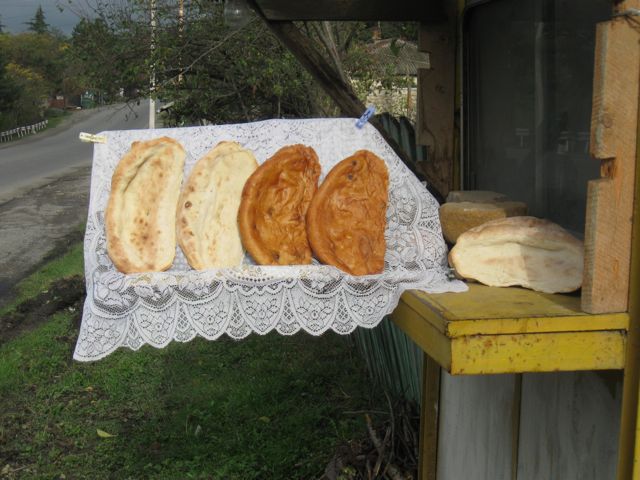
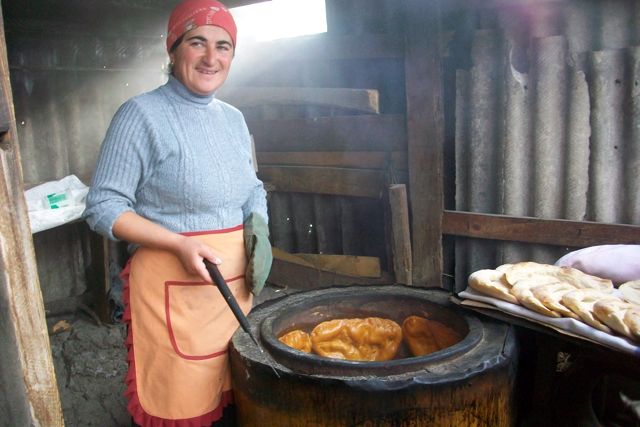
It was called Nazuki, and it is made from milk, sugar and raisins and baked in a terra cotta oven called a Tone. We stopped to buy and look at the oven, which was covered in a huge old woollen coat. Delicious.
The next stop was to buy the most wonderful mushrooms right in the Rikotu Pass.
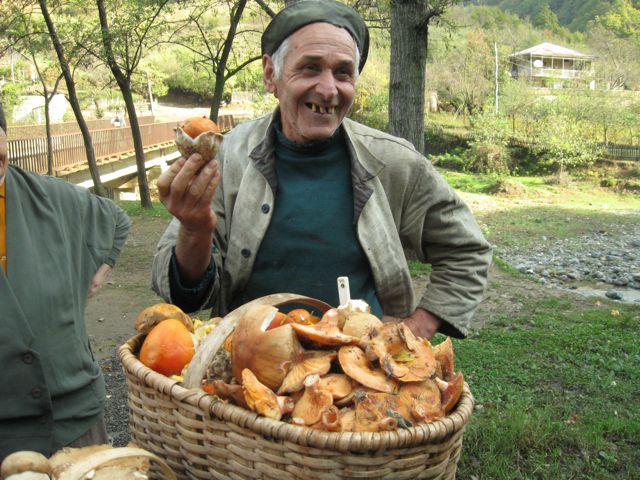
They were being brought down from the mountains and sold at the side of the road. Marika translated the Russian name for these large yellow ones as Caesar's Mushrooms. She later asked the restaurant we ate lunch in to cook them for us. They also were selling hazelnuts, walnuts and the Georgian sweet called chorchella, made from walnuts and grape juice on a string. In the East it is made with wheat, but in the west with corn.
As we descended , we had more glimpses or rural life -- cows and pigs on the road became frequent, and each house has its own compound with some metal security, fruit trees and animals, all quite neatly kept. It was also a major pottery making area.
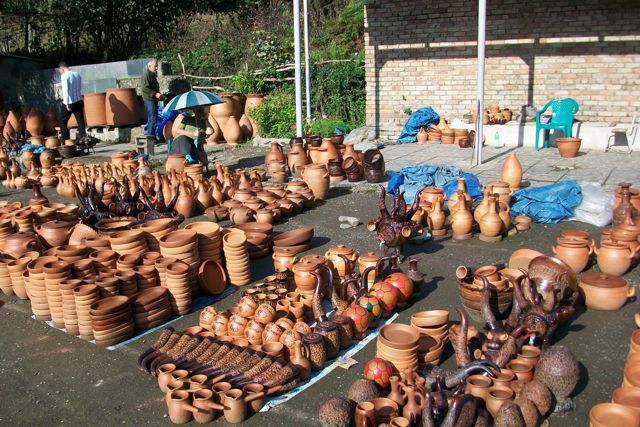
Our next stop was at Nokalakevi Fortress which dates back to the 7 or 8 century B.C. Archaeology students from Cambridge and Oxford come here every summer to help with the excavations. Many pottery and wood pieces have been found, along with pieces of ewer which are housed in the local museum. We wandered around the fortress which is spread over 20 hectares and found the secret tunnel to the river by which supplies came and went.
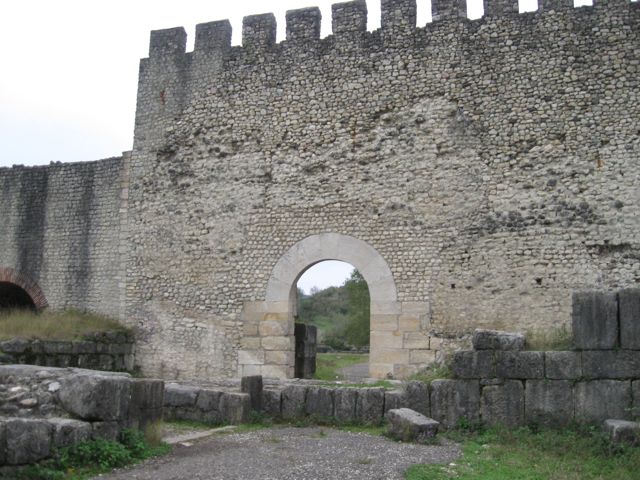
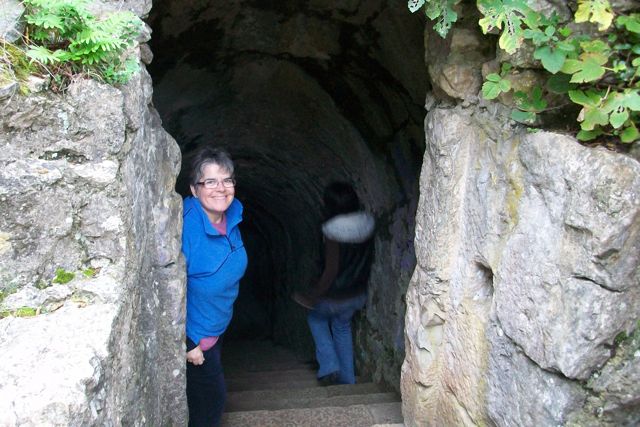
Lunch was an example of a Georgian feast known as supra - enough food for an army. Chicken salad, fried potatoes, salad of cucumber, tomatoes, onions and chili; Megrelian khachapuri (which has cheese on top), mstvadi (shishkebob), bread, and homemade wine special to this region. Megrelian food has more spices than some of the other regions. This region also has its own language which is not written or understood by non-Megrelians.
The last stop of the day was the Khobi Monastery. The long, well-layed cobbled path was an indication of the money this monastery house. We're now more in a tropic climate zone, evidenced by the palm trees and agaves along the path and around the monastery. Much construction and renovation going on. Frescoes still in tact, which is more typical of western Georgian churches than eastern ones.
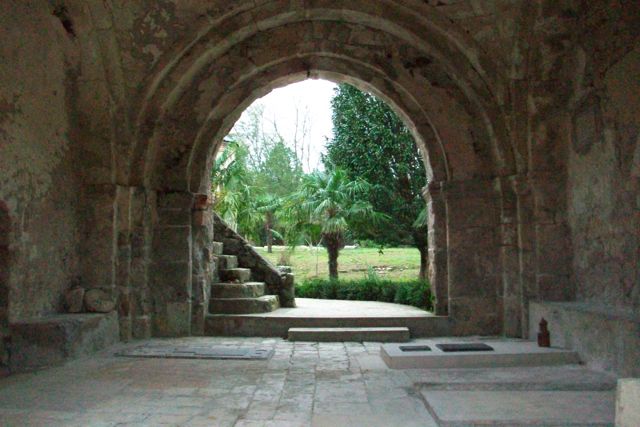
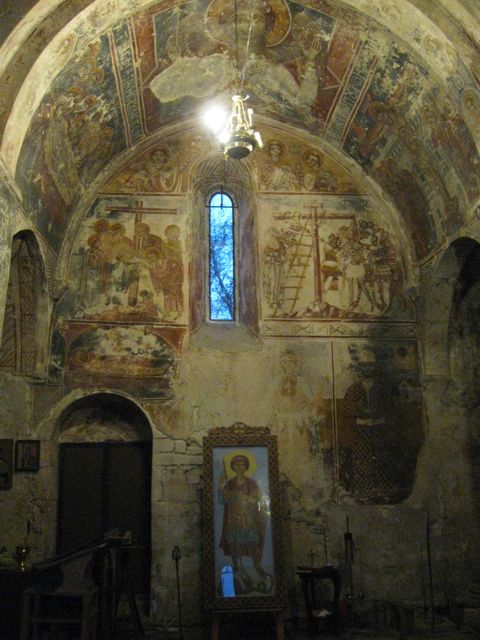
It was dark when we left to drive the 24kms into Zugdidi, and we discovered that indeed the whole of Zugdidi was dark as there was a power cut. It is actually a fairly large town, but we couldn't see any of this, and with much asking of directions found the hotel by around 7:30. We ascended several staircases as it was above some shops, and were shown to our room by candlelight - with A/C and TV!! oh, and as we discovered also a mosquito. The beds were comfortable and we went immediately to bed in the dark. Needless to say we had just fallen asleep when we were woken by bright lights as the power was back!
Day 5 Sunday 24th October Zugdidi to Mazeri
We breakfasted at 9am with wonderful yoghurt, white cheese, bread and egg -
Turkish Coffee without sugar was wonderful as an addition.
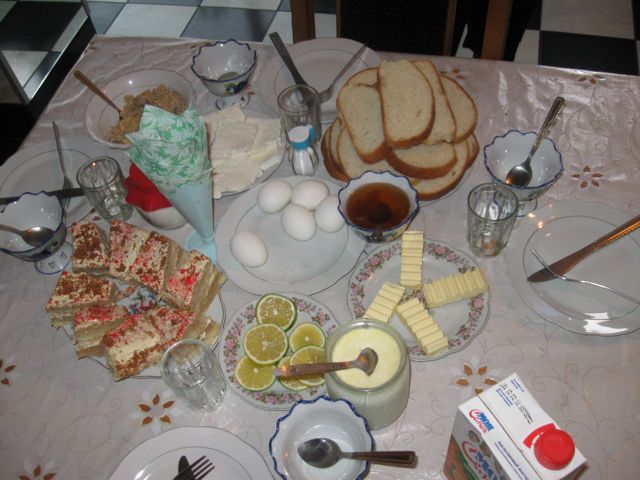
The first stop this morning was the market - an absolute thrill for a couple of hours - very traditional and the stall holders were so friendly and all wanted their photos taking, so I set Beth on the task! We sampled and enjoyed seeing the spices being made, the walnuts being ground and just such an active and live market. The older women were doing most of the work with the spices and food, the men the meat and tools, and the younger women the clothes and other goods.
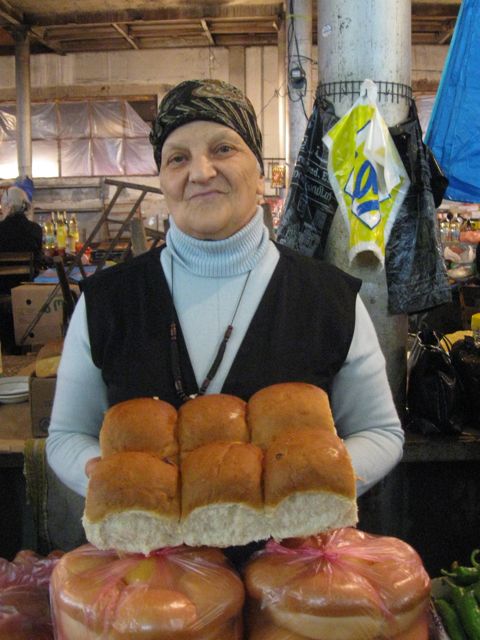
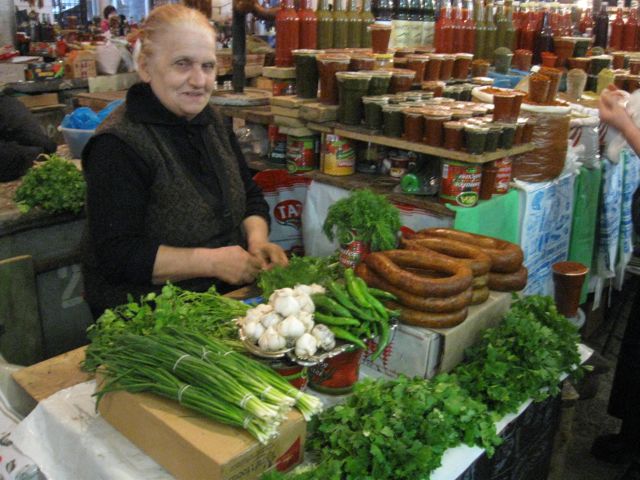
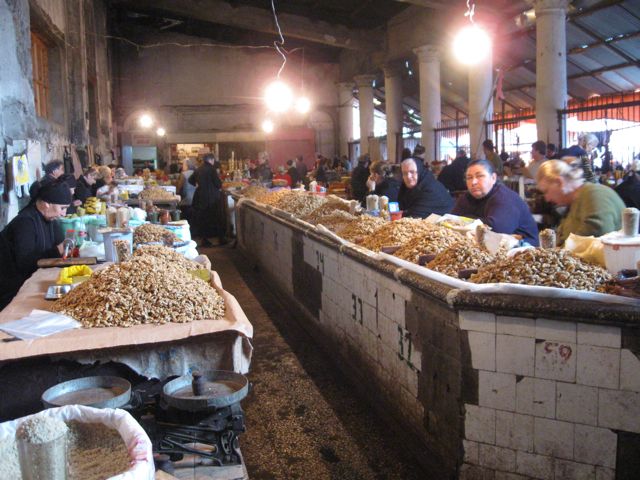
Walnuts
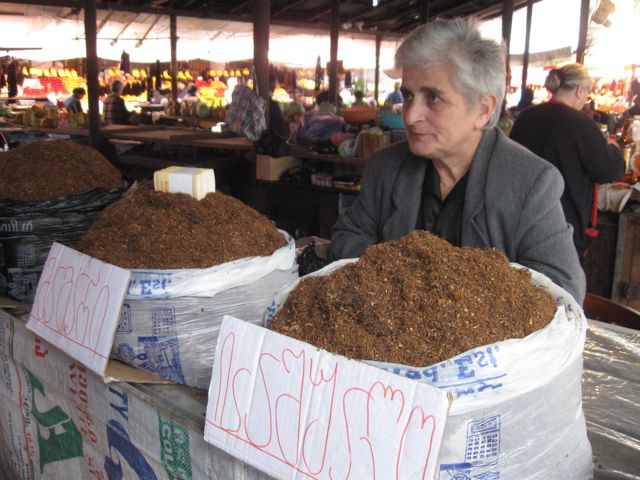
Tobacco
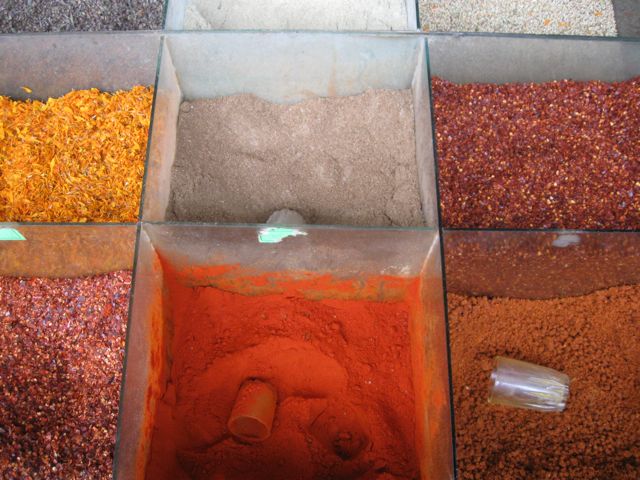
Spices
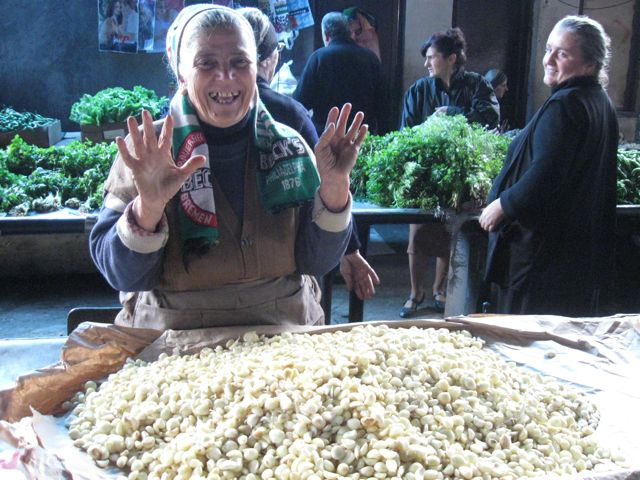
Garlic
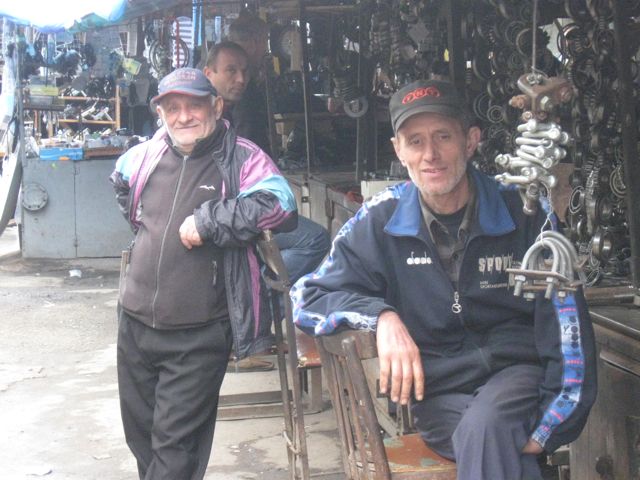
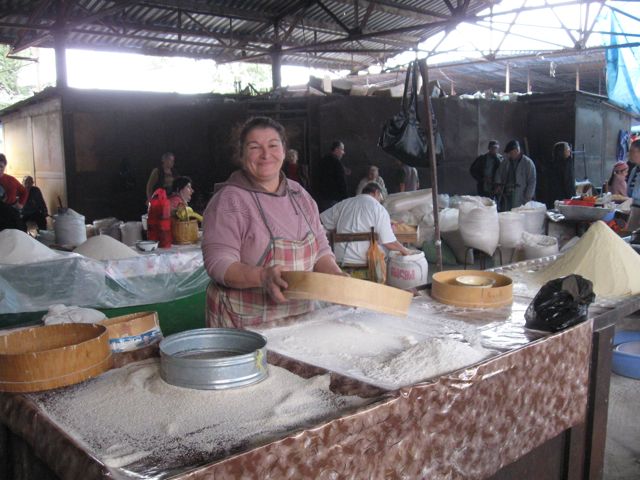
Flour
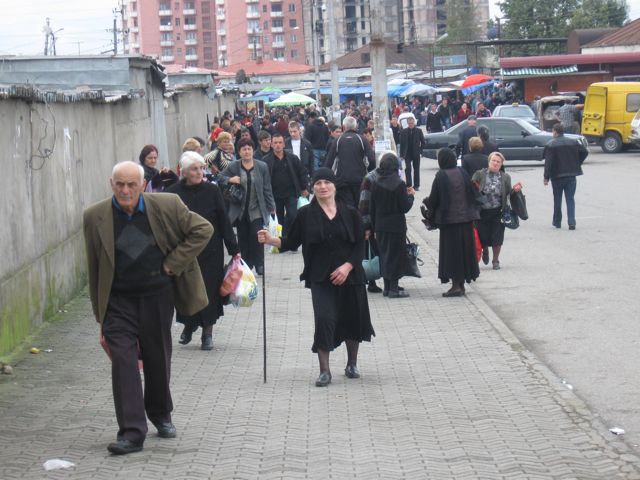
Outside the market
At midday we met Zura and he drove us to meet our new driver Taras who would drive us to Upper Svaneti. The distance is 140 km. The initial part was asphalt road but later on continued as a gravel and dirt road for which the jeep was essential. Taras is a Svan, so had driven down in four hours in the morning, and was excellent with the roads which had many potholes and landslides, but the most spectacular scenery so special because of the autumn colours, and eventual glimpses of snow-capped mountains. After about an hour we saw a small group in national costume being filmed on the hillside. We stopped and asked what they were doing - it was apparently for a competition on children's folk performance. The lady organising it recognized Beth from her Georgian singing on television, so it became a very special encounter.
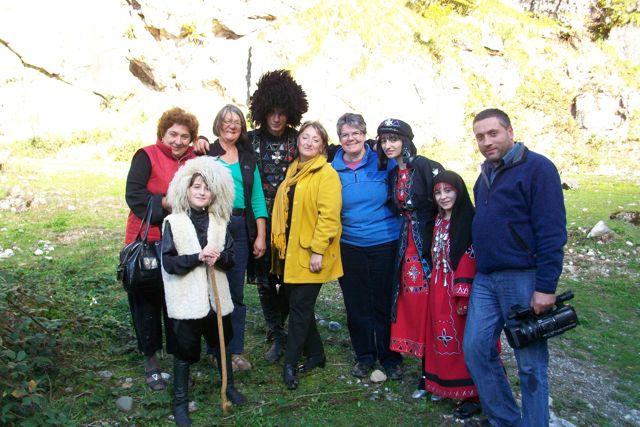
We stopped at the Enguri hydro-electric station which was built during the Soviet times and was huge. From then on we followed the dam, which was a fantastic turquoise colour, and then the river which was very fast flowing between the steep sided mountains.
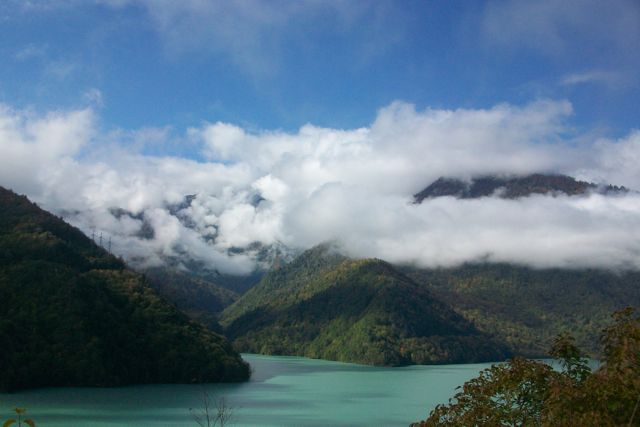
The forests are natural, so the autumn colours were spectacular, and it was only as we got higher that we encountered pine trees as well. Lunch was in the local restaurant in the village of Tsitskhvari. We sampled our first kubdari, which was a bread filled with ground meat and spices.
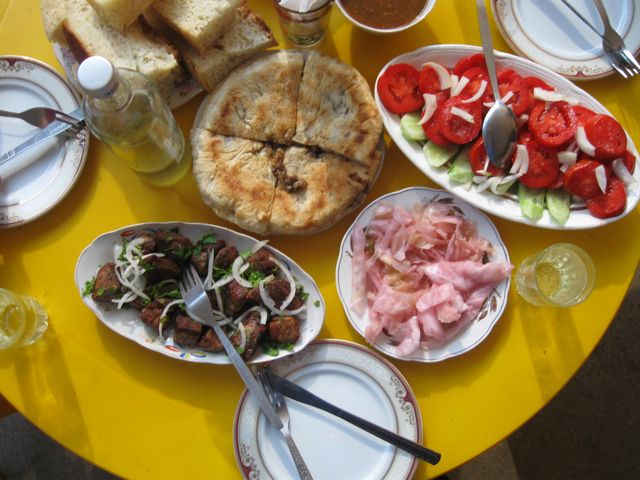
Beth, Marika and Taras
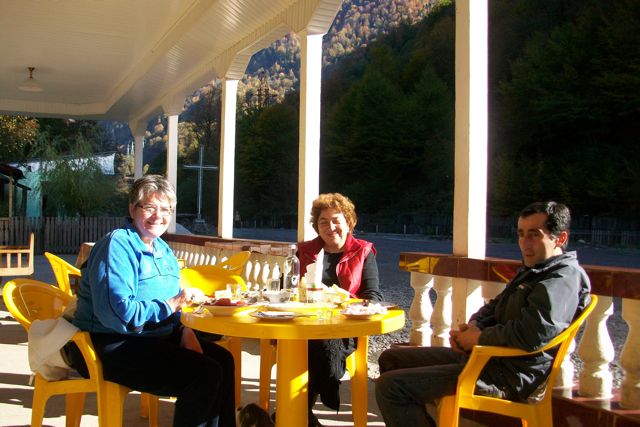
We sat out in the sunshine, and enjoyed a family of piglets who came to visit!
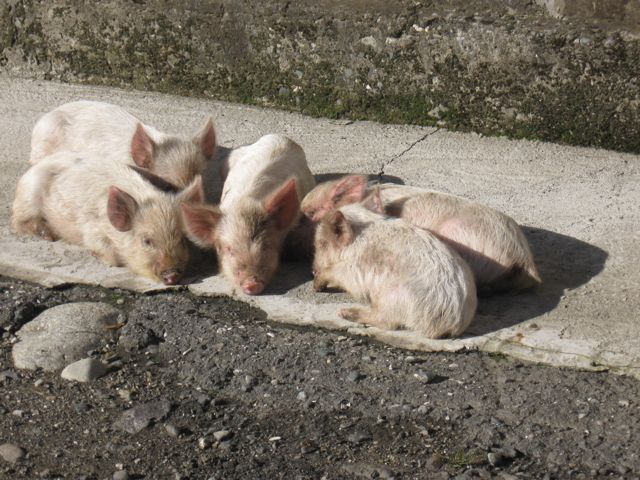
There was very little traffic as we drove higher and higher, with many white waterfalls over the Baal mountain range to reach high mountain pastures and small villages nestling in the valleys.
Unbelievable autumn colours
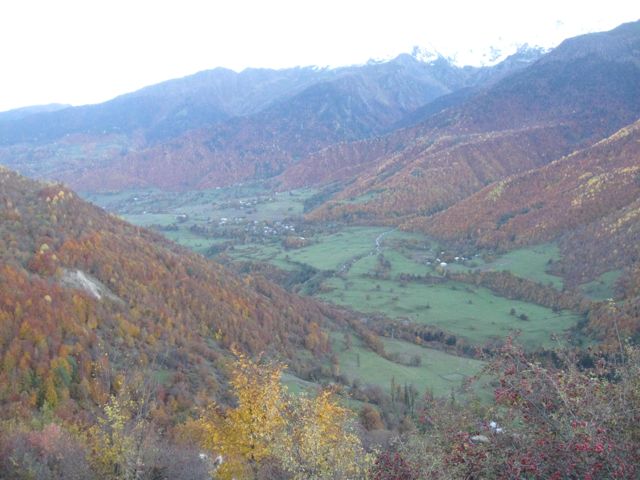
We finally came to the community of Becho which was a centre for trade connecting Svaneti with North Caucasus. even though the light was fading we caught glimpses of the twin-peaked Mount Ushba (4700m) covered in snow.
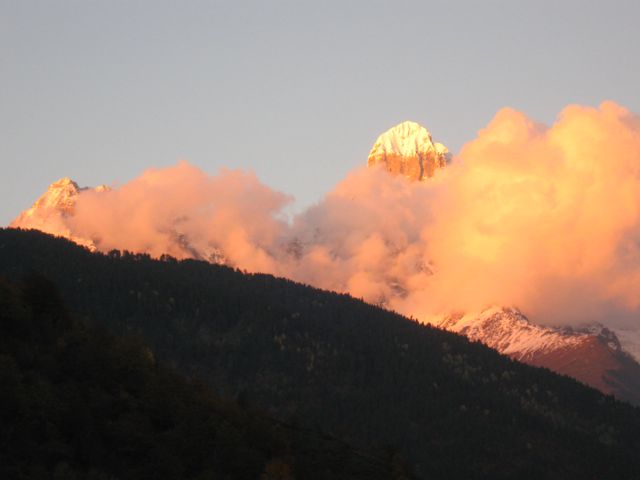
By Svan folklore Ushba is a male mountain, living in a very special environment the Svans viewed mountains somewhat like living creatures. Becho is in Upper Svaneti, but it isn't Free Svaneti, as there were feudal lords here. We heard a lot about this concept as it is still almost a medieval area, and feudalism was common, but some areas called Free Svaneti never had nobles, and are still considered very free-spirited. We were staying at around 1800m. A spectacular day culminating in dinner and overnight stay in the local guesthouse, which was not expecting us, but welcomed us none-the-less. Of course it was dark when we arrived, so we couldn't see a lot, but the guest house itself was large, and the lady running it Zaira was struggling a little, living here with her brother who is a border policeman, bringing up his youngest child who was five, working herself in Mestia 24kms away, and helped only by an elderly IDP (Internally displaced person) from Abkhazia. A wonderful old-fashioned heater was brought to our room - it was cold, we needed extra blankets, and slept in our thermal underwear!
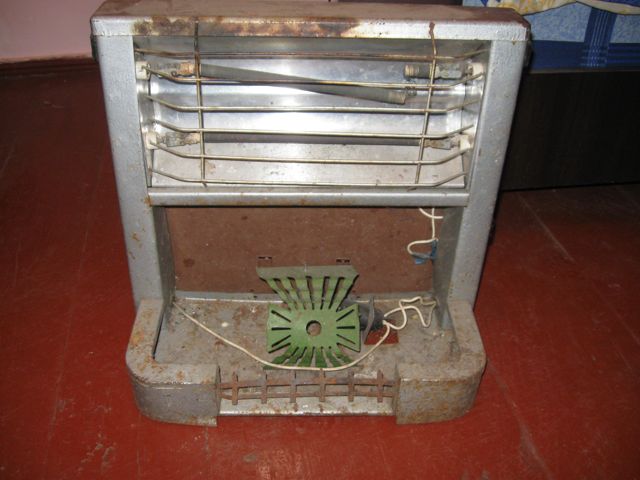
The meal included special Svan Khachapuri
which is the bread with melted cheese inside. The make particularly good cheese
in this area. Again wonderful homemade thick yoghurt, and their own honey.
Day 6 Monday 25 October Mazeri - Mestia
The Svans have their own language, which is not written at all. They also speak
Georgian, and that is how Marika communicated - people outside Svaneti do not
speak the language. Breakfast in the guesthouse at 9 am, but prior to that Beth
woke me up to see the wonderful views of the snow-covered mountains, and even
the moon falling behind one of them.
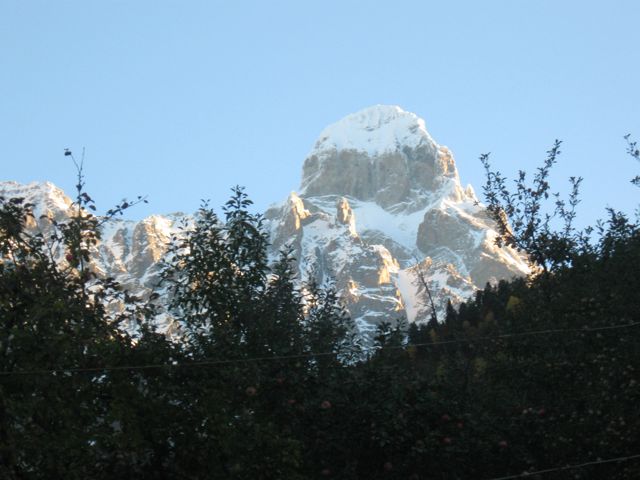
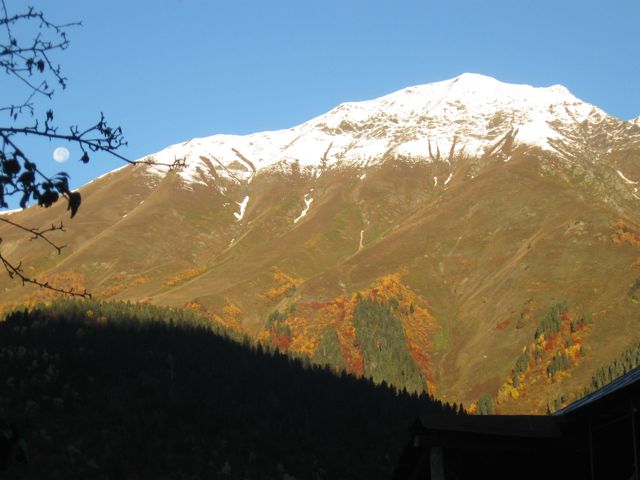
We managed a simple wash in the family bathroom, and today donned warm clothes. From 10 am to 2 pm we walked in the mountain pastures from the village towards Mt Ushuba glacier - just wonderful scenery all the way, and magnificent to be out in such pure 'alpine' air.
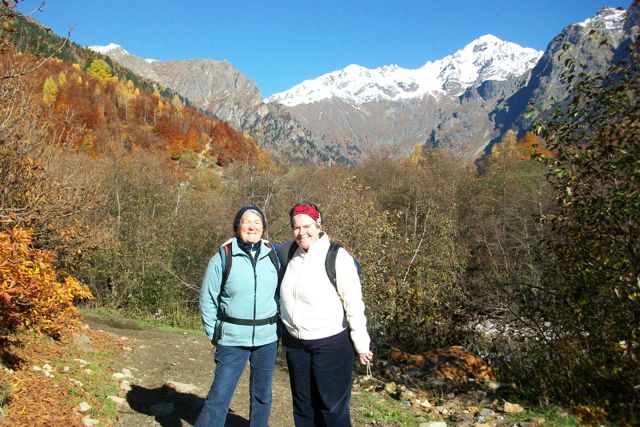
This is the start of many mountaineering trails, but the mountain itself is difficult to climb and has taken many lives - we were not tempted, but loved the hiking. We came to a small isolated church, and soon afterwards turned back when we encountered a river too deep to cross!
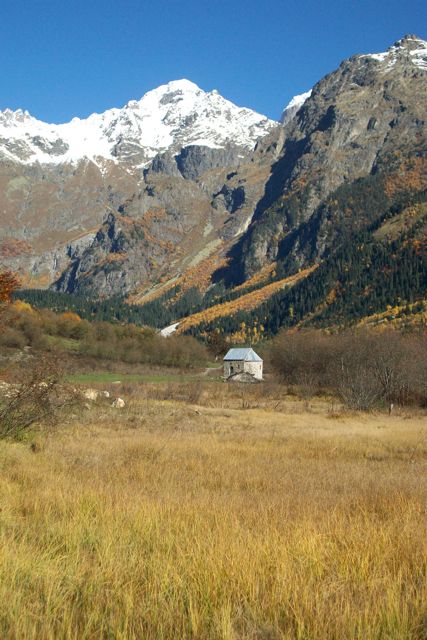
On our way back we encountered an elderly man digging potatoes in his field - this is the main crop of the area, and everywhere they are being harvested before the winter. He was wearing the traditional Svan hat made of felt with the threads over the centre in a cross pattern. St George is the favourite saint in Svaneti.
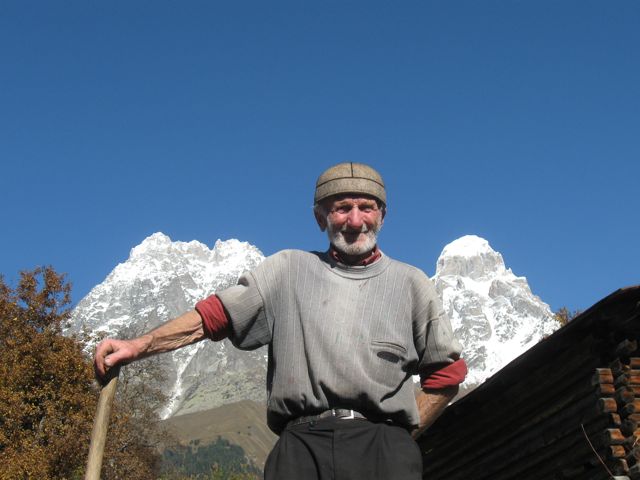
Zaira had prepared a feast for lunch on the typical svaneti stove.
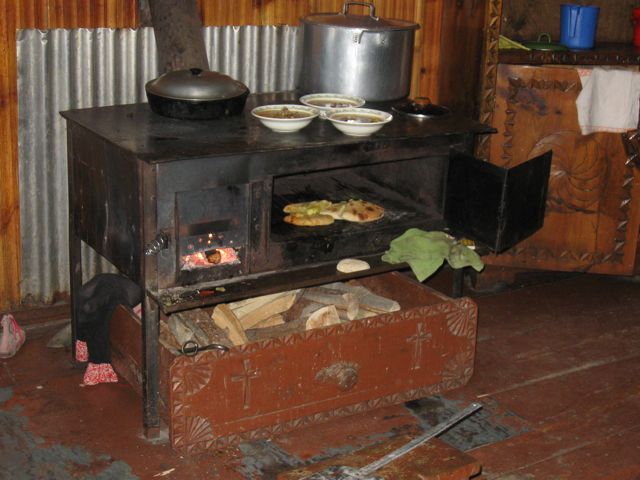
The kubdari was delicious.
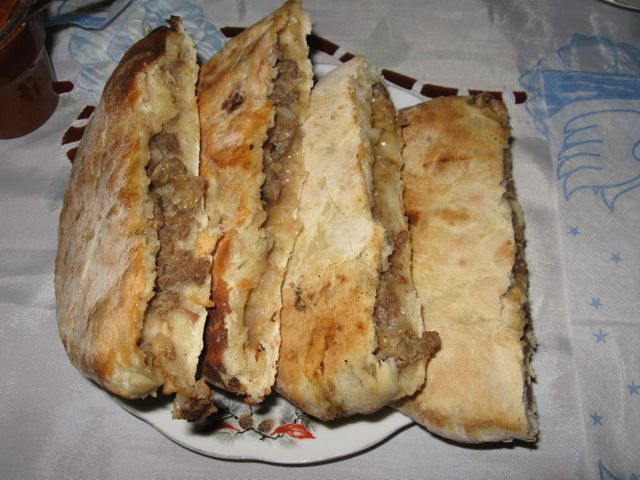
We were picked up by Taras, the driver to bring us to Mestia where we sill stay with his family. We brought Zaira as well as she had work to do. The road is rough, so although only 24 kms, it took about an hour, but we had some photographic stops on the way. We had great views of snow-capped Mt Becho 3367m at first - this has a permanent cap.
We stopped to take photographs of the svan towers in Latali. Latali was the first town in Free Svaneti to have been attacked by the Dadeshkelianis - the powerful feudal lords.
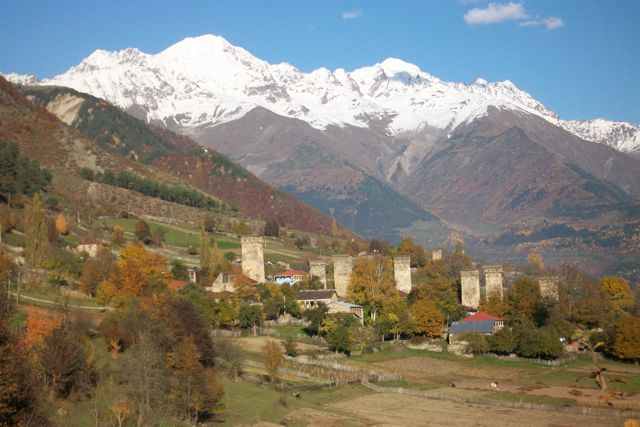
The next community was Lenjeri - by now we were getting blase about lines of
Svan towers! We did find out about a concert here tomorrow which we may attend.
Arriving in Mestia was a bit like coming to the big city, the capital of Upper
Svaneti, here dominated by snow-capped mountains, and many Svan towers. They
were basically family watch towers, built for defensive reasons between the
9th and 13th centuries, but also symbolized the strength and standing of a family
within the community. Because there are so many in Mestia it must have been
an important place. Only about 175 towers remain in the whole region today.
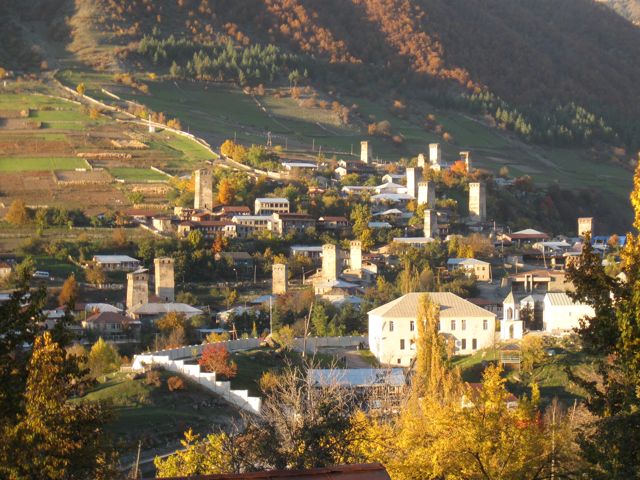
View of Mestia from our guest house
We were totally amazed at the amount of construction going on throughout the town from roads to restoration of buildings as well as new builds. There used to be an airport, and they are planning to re-open this in the next year or so as well as building the road from Zubdidi - they have a lot on their plates, but I think we have arrived ahead of all the tourists, but a little too late for the total peace we experienced in Mazeri yesterday and today. There are also ski lifts being constructed in Mestia, but the roads really need fixing first both in the town and along the way from Zugdidi.
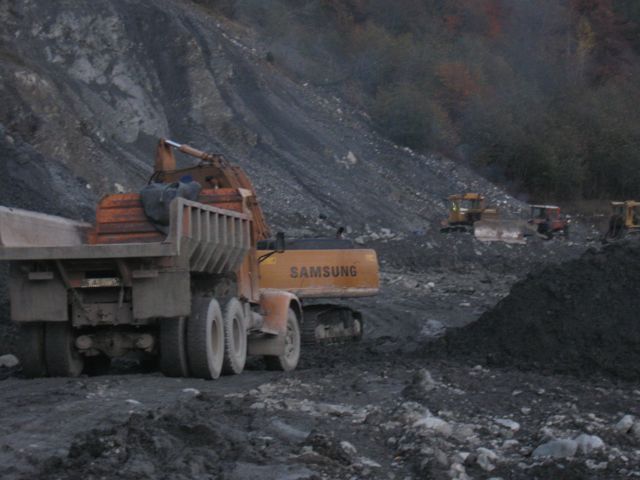
The guest house is simple - I am sure we have taken Taras bedroom - he and Khatuna have a young family of three children, and the house is above the town, old with large rooms. The family are lovely, and the Khatuna works so hard. The Mother-in-law also lives here and is an accountant. They have been busy since our arrival, baking in the big stove, feeding children and then of course us in the Georgian style of a feast (supra) Just when you think all the dishes have arrived on the table, another one comes! The room has a heater, so the house feels warm in the areas we use. The bathroom has a big boiler, so lots of hot water for the morning shower.
Day 7 Tuesday 26th October Mestia
Breakfast included home-made grape juice and corn bread.
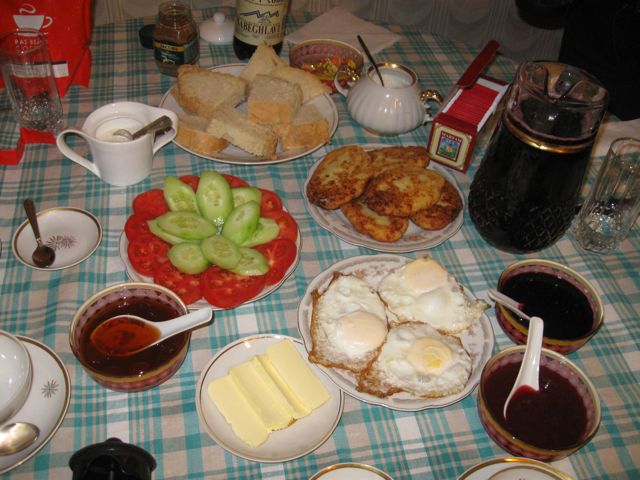
Taras dropped us at the village of Laghami - the furthest village that is part of Mestia on the opposite side of the river from us, and we spent the next five hours wandering around here and the next village, both of which have a string of svan towers and are still quite medieval. The gatekeeper for the church turned out to be the Khojelani family, and the young son opened this up for us. It is two storied (tiny by our standards) and has wonderful frescos dating from the 13th century - still in occasional use today. The fresco is of the benefactor of the church.
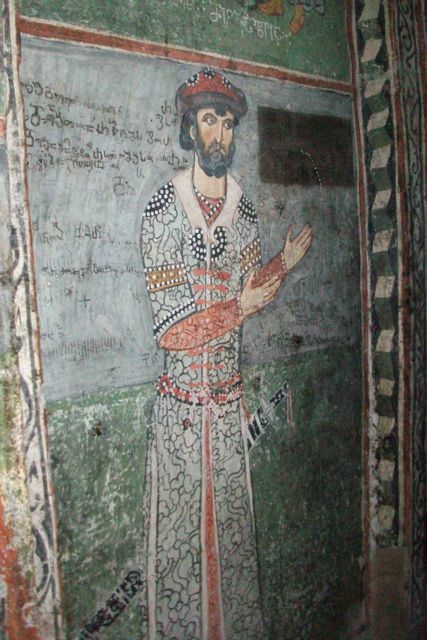
We then met the widow of the painter Leo Khojelani who recently passed away, and saw some of his paintings - she hopes one day to make a gallery. The svan tower paintings were especially inspiring - full of different moods. The father of the boy who showed us the church turned out to be an artist too, so we went to see his paintings - also many with svan towers. Beth and I both thought of Ubud in Bali, and imagined in the future this could become an artists colony.
Our other encounters were with families of alpinists who had died. One Sergio Batalini had died in 1983 rescuing the other 40 members of his expedition, and his sister showed us his grave - he had a street named after him, and a monument in the graveyard.
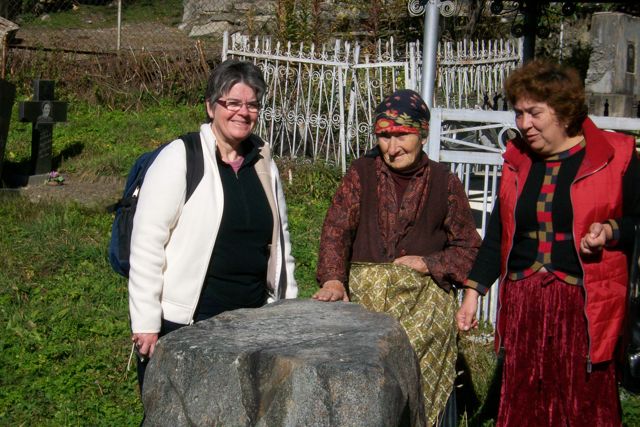
Another famous mountaineer who died, Mikheil Khergiani has a house which is being renovated, and is already a museum. We just saw the traditional hub of the house, with the cattle stalls and carving inside the kitchen and cooking area.
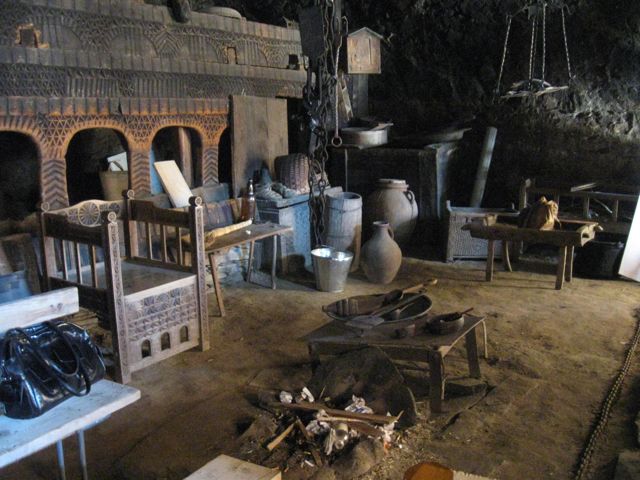
We wandered on to the next village, and of course all the time we had magnificent views of the mountains, the towers and day to day life.
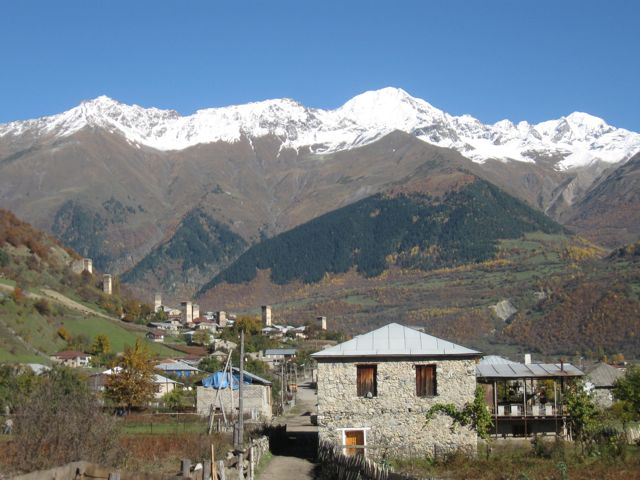
The people are busy getting in their potatoes
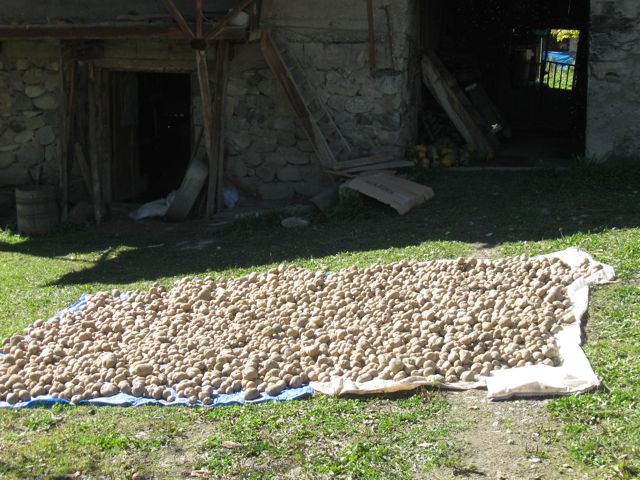
and cutting the sweet corn, bringing everything back to the villages on bullock drawn sleighs.
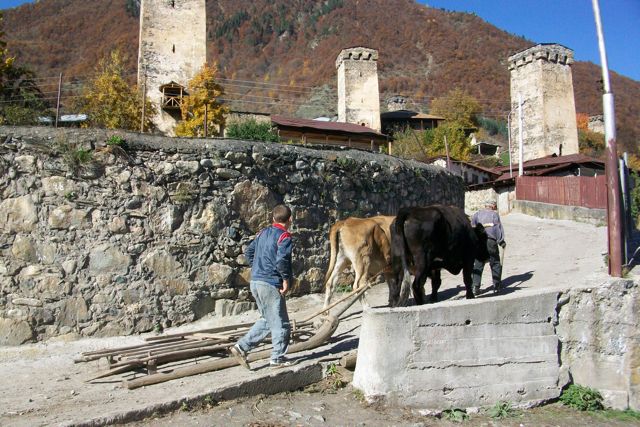
In the second village we climbed right to the top through the medieval streets and tunnels. The last house has their family house and tower in tact, so the young boy unlocked it to show us round, and we then climbed up into the tower - we did two of the five stories, but got the idea what a safe place it was to close yourself off from enemies and attack from above.
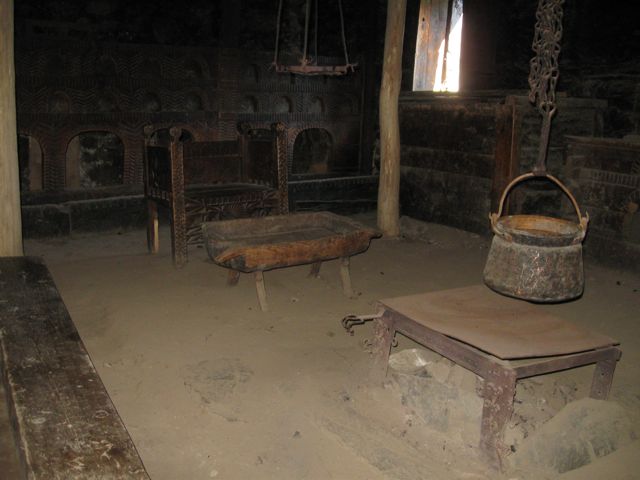
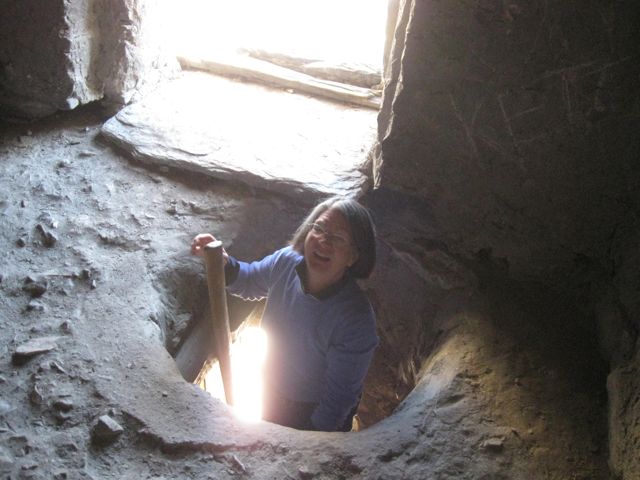
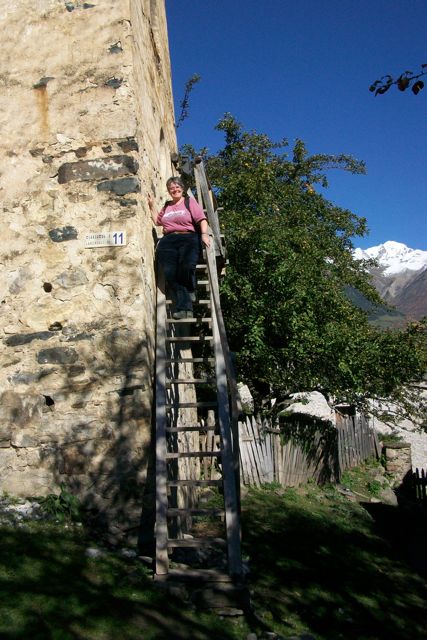
The views again were stunning, and being out in the fresh air was wonderful. Although frosty in the morning, the sun was warm during the day and we could shed a few layers.
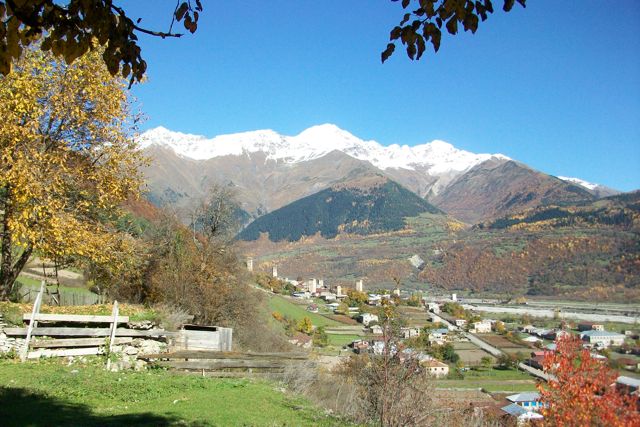
We walked all the way back to the guesthouse for lunch at 3 pm a big meal for the middle of the day, and then set off for Latali where we had heard there was a concert at 5 pm. When we got there, there was no power so they hoped to start at 6pm. We found someone (Giorgio) who had the key to the Matskhvarishi Church which again had wonderful frescoes from the 11th century, When we got back to the hall, there was a great gathering of children, and Beth made friends who guided us, and had good English skills.
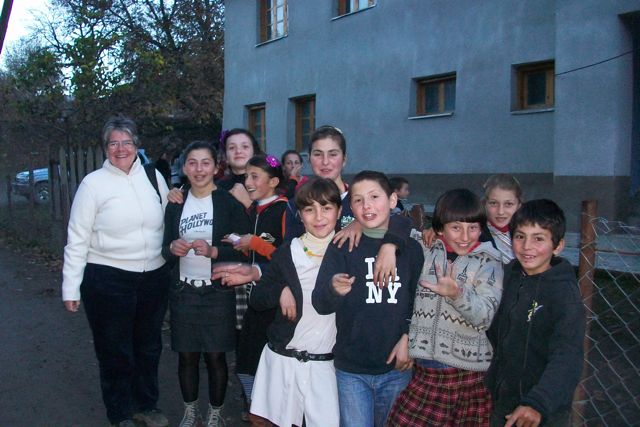
When we finally got in the village concert hall (constructed during Soviet times), we had another half hour to wait while the sound system was organised! The elders (male) of the village sat patiently at the back, and when they did sing, they had strong voices. There was a smaller mixed choir which sounded good, and the rest was prose and poetry, the best being young children who could recite so well with expression and without inhibition. We extracted ourselves at 7:30 when they were giving prizes for a bible competition. Amateur dramatics at its disorganised worst, but an experience put down to the rich tapestry of life.
The stars were fantastic as we came out and Taras patiently drove the half hour over potholes back to Mestia and dinner. Tonight there was an aubergine and walnut dish which I particularly liked.
Day 8 Wednesday 27th October Mestia to Ushguli
Power shower over the bath and bathroom! I had time to do the diary before breakfast at 8:15. The children don't go to school until 9:30, possibly partly because the sun gets up over the mountains later. Breakfast was another feast with a cake baked last night, and a dish of mashed potato and Svaneti cheese which was delicious, but difficult to serve.
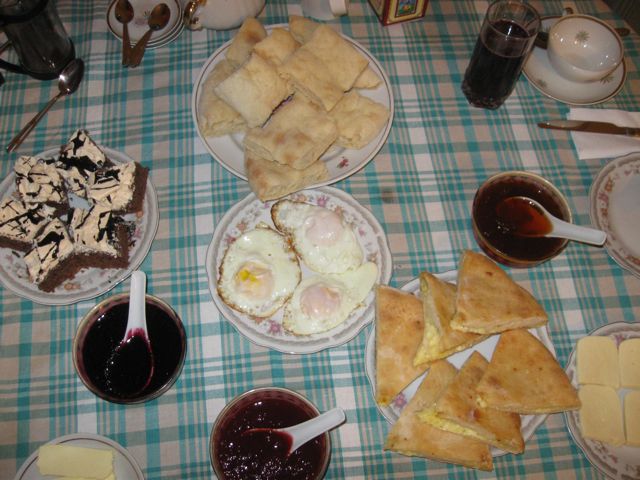
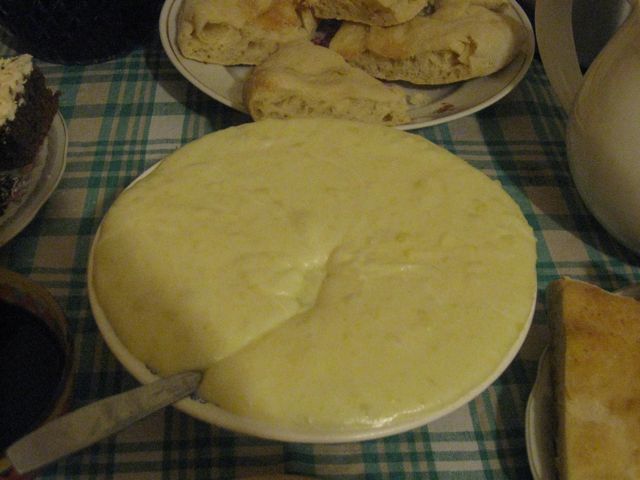
We left for the 45 kms journey to Ushguli the highest continuously inhabited village in Europe at 2200m. The roads are incredible, and the journey took us around 4 hours - it would be impossible in anything but a four wheel drive vehicle. It was spectacular all the way really, and I felt confident in Taras who is a careful driver and understands the terrain of potholes, landslides and stream beds well.
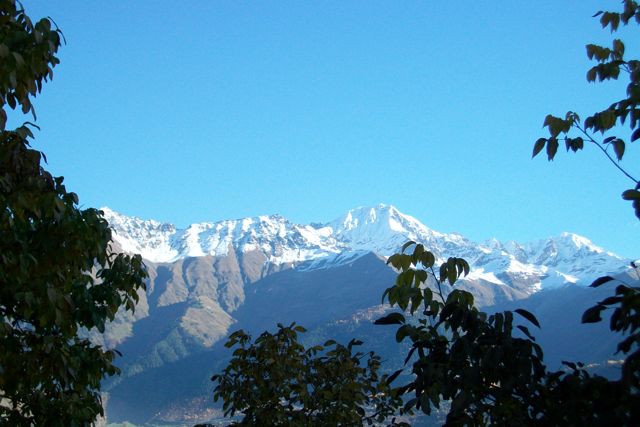
We made one stop at a small mountain lake before the top of the first pass - a pretty picnic spot surrounded by snowy mountains. The frost was still on the ground so it was easy walking. I found giant mushrooms, but were they edible?
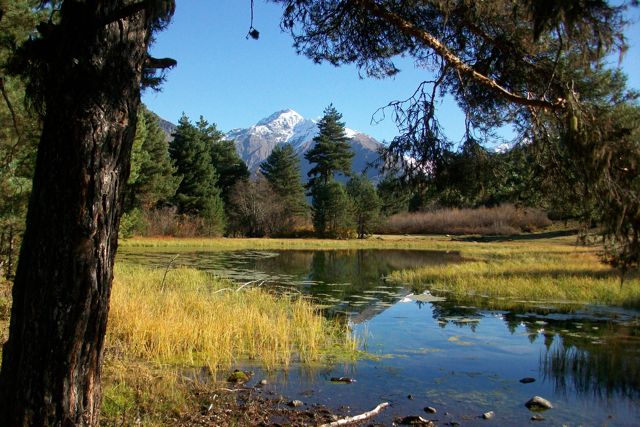
The weather was again clear as we climbed from one pass to another valley, getting different views of snow clad mountains as well as remote communities such as Mulakhi, Ipari and each one had its own set of svan towers, and some abandoned houses.
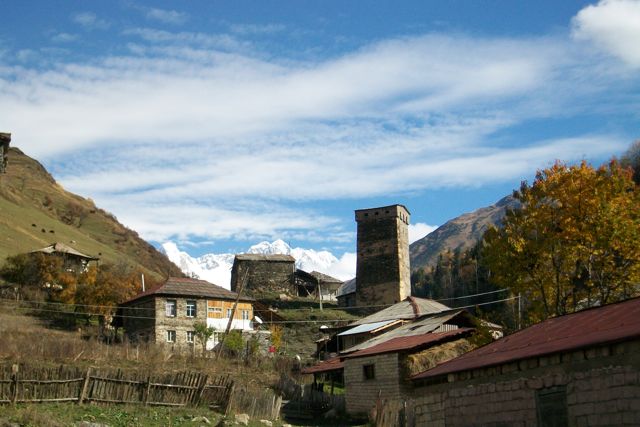
First view of Mt Shkhara (5068m)
The final gorge coming up to Ushguli was particularly difficult with the road constantly traversing a landslip, but around 1 pm we arrived under the shadow of Mt Shkhara (5068m). We had our first glimpse of this giant of nine peaks quite a way back down the valley.
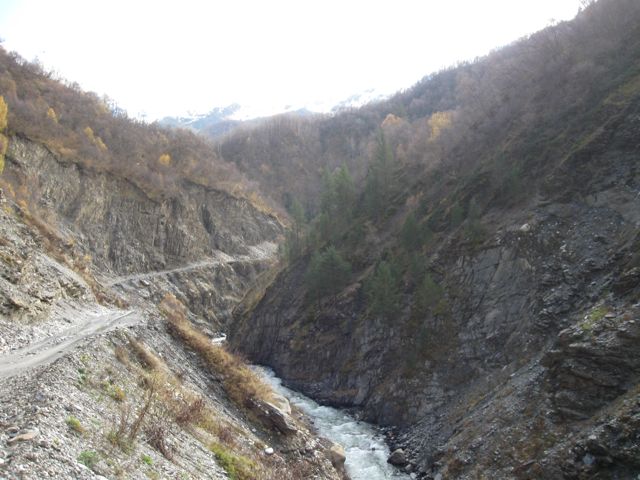
Our guest house got a grant from USAID and is simply made but using a lot of wood, Of course there is no electricity at the moment, and the heating is in the kitchen in a different building, but now is the moment to put on all the layers we brought. The owners are a brother Laert Nizharadze and sister, Ela - he is a mountaineer, and they obviously have lots of guests during the climbing season. She goes to Tbilisi for the winter and works in cloisonne!
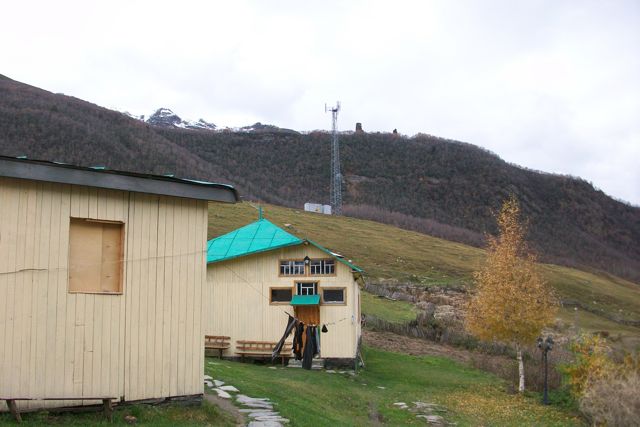
Ushguli comprises four villages, and we are staying in the last one Chvibiani. This whole area has the UNESCO World Heritage Site status since 1996. Because of its isolation, it has retained its medieval structures and atmosphere. Each of the villages have towers and a mish mash of stone built buildings joined by manure covered alleyways. It is a very bleak and beautiful spot, and only as recently as 1975 got television. We had a picnic lunch prepared by Taras wife before setting off to explore.
The village was fascinating, and the roofs of slate, buildings and doorways so wonderful. We met some villagers and saw others working together to put a roof on a building. They have apparently got the potatoes dug for the winter, and are now bringing hay back from the fields for the animals, as before long the snows will come and they will have to bring the animals back from the hillsides. In the village pigs, piglets and hens wander freely, whereas on the hillsides there are cows, mountain goats and horses.
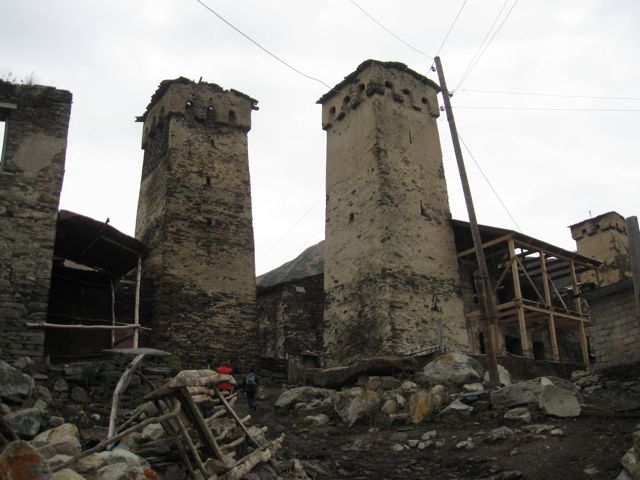
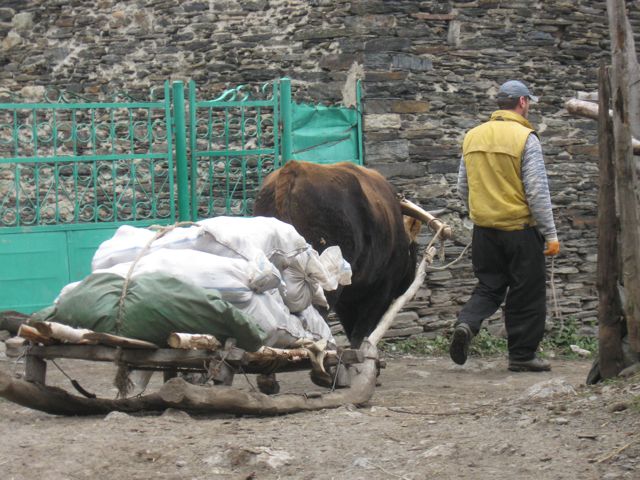
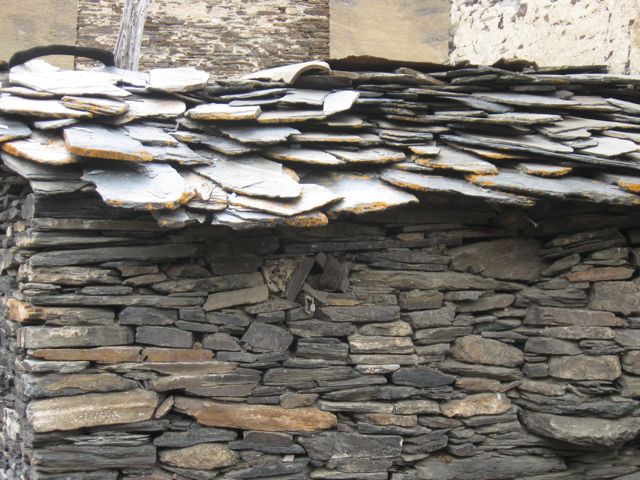
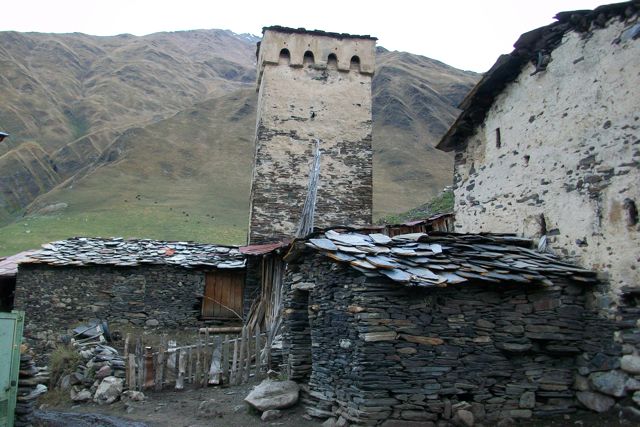
As we hiked up the valley towards the Shkhara Glacier (unfortunately now covered in cloud, we were passed first by a herdsman on foot going to fetch his cows, and then another on horseback. It was a super walk up the valley - the bare mountains reminiscent of Scotland, but given we are already higher than anywhere in the British Isles, the scale was somewhat different.
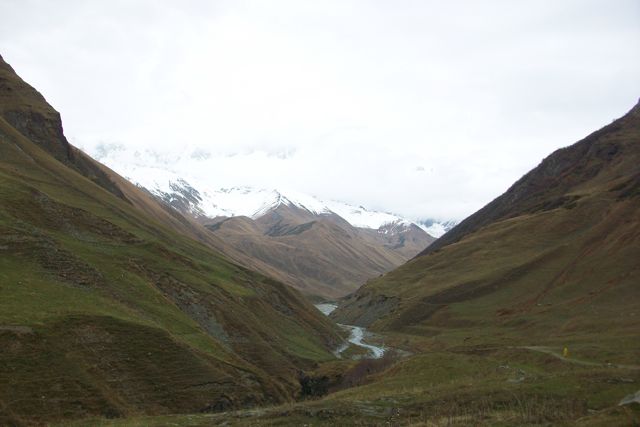
Looking back at the towers of Ushguli, you could see what a defensive position they held for anyone crossing those mountains.
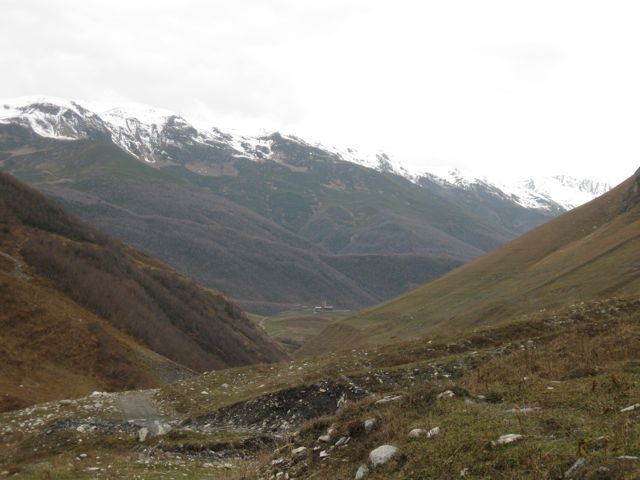
Back at the guesthouse the eating area was so lovely to sit and hang out, we could have stayed here for a few days and had time to really relax. This meant that Stephanie had some diary time!
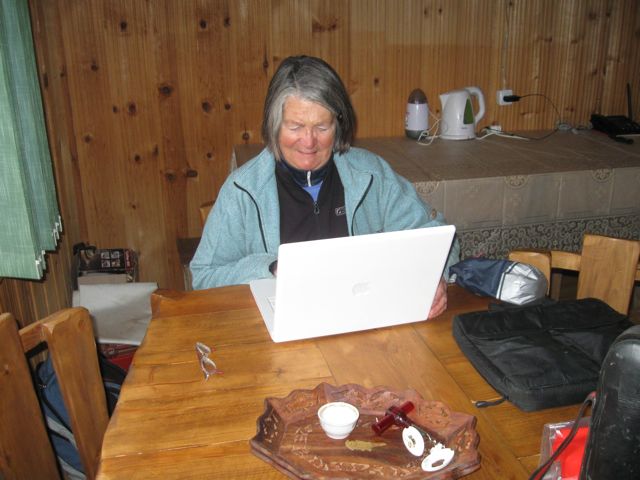
We had our supper, and have adopted the Georgian tradition of toastmaster - tonight it was Marika's turn to propose toasts - she had provided the cha cha (Vodka) - in Soviet Times everyone came to Georgia for the vodka! Ela meanwhile had baked bread for the next three days.
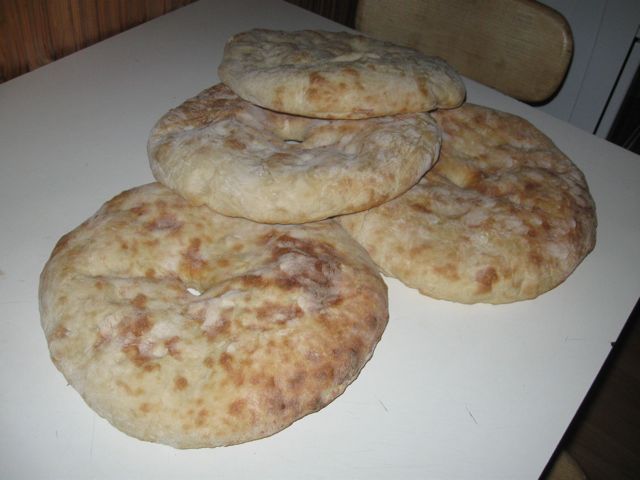
Day 9 Thursday 28th October Ushguli to Mestia
A clear morning, and Beth and I took a walk before breakfast to see Mt Shkhara - absolutely spectacular - how lucky are we?
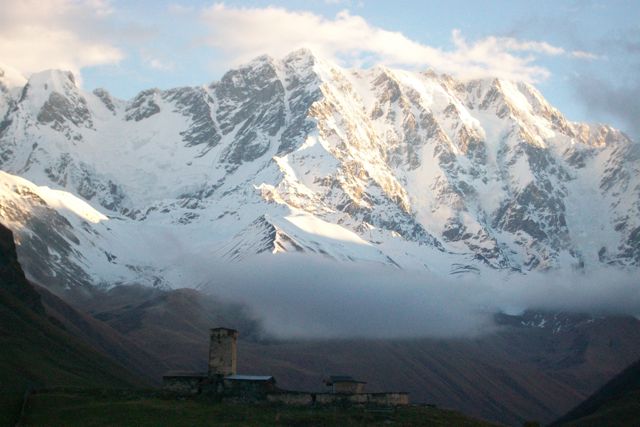
After many photographs we walked through the village, and at each house a lady was milking a cow - so interesting - I know there must be skill involved - something I would like to have a go at! They each had their galvanized bucket held at an angle, and went back into their house when they had finished.
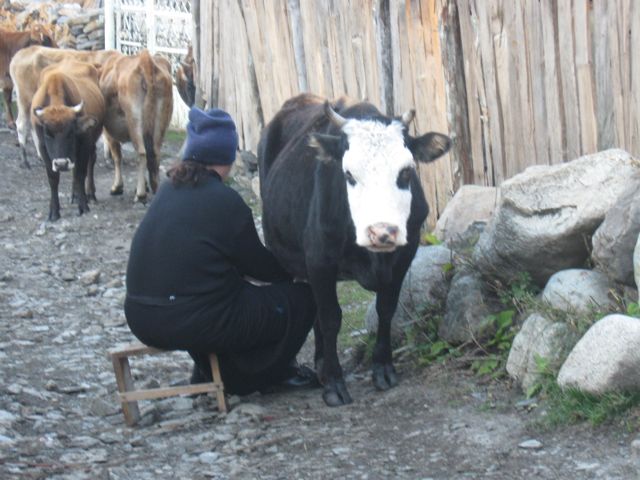
Goats came out to greet us!
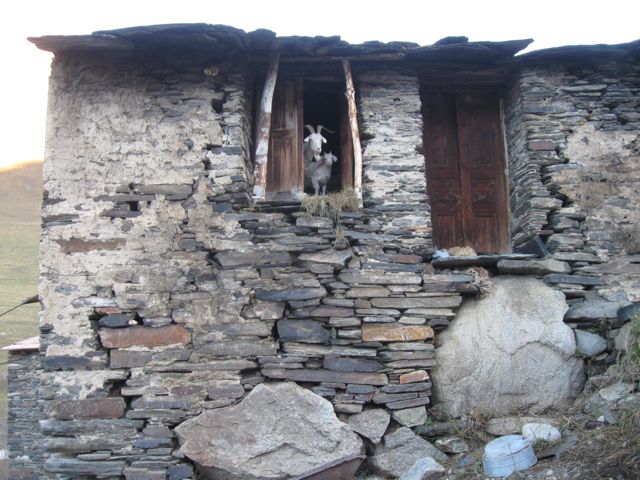
In Mestia at the guest house there was no fresh milk the first morning as the cow hadn't come home the night before - they are let out in the daytime to graze freely! In Ushguli there were lots of piglets and goats which also got the same treatment.
After breakfast, which included rice pudding, we set off to explore the lower villages of Ushguli, Markmeli and Chazhashi, just a km or so down the valley, both very small and full of svan towers.
View of Mt Shkhara from the guest house
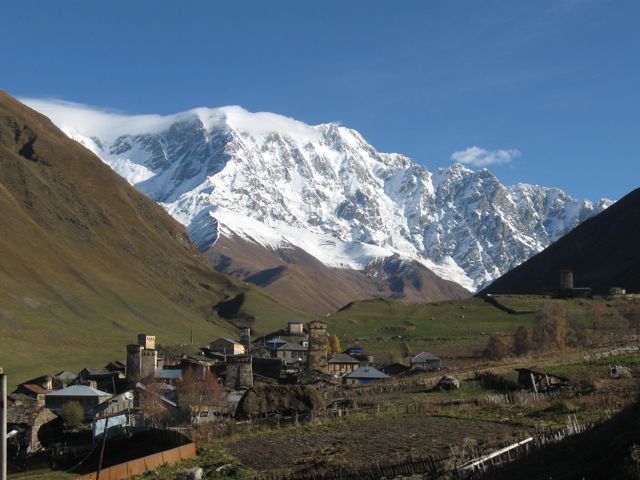
In the first village we had an amazing encounter with a family, which ended up with a two hour visit in their old 11th century family home and tower.
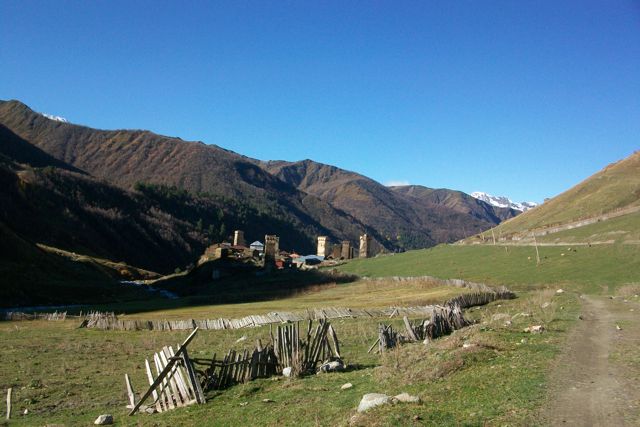
The two sisters took us in with torches (no power in the daytime), with great apologies for all the manure we were standing in! Similar to the museum of the mountaineer in Mestia, here was an area they still used as originally intended for their animals in winter time. The oxen, cows and sheep all have a place, and there already were potatoes stored for the pigs, and a chicken roost and chicken house. Originally the family would also have shared these quarters, sleeping above the animals to get their warmth.
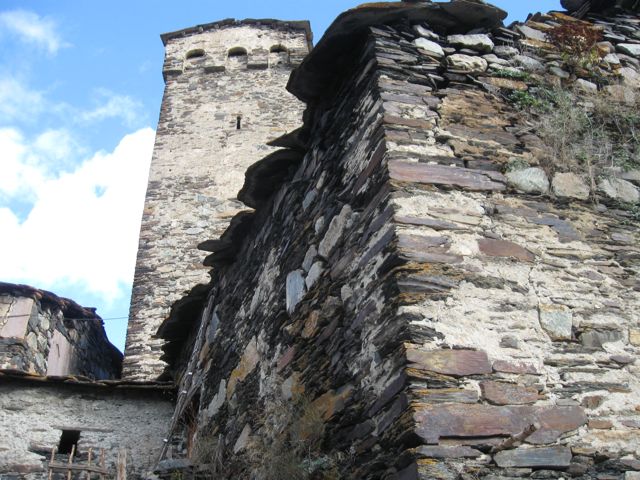
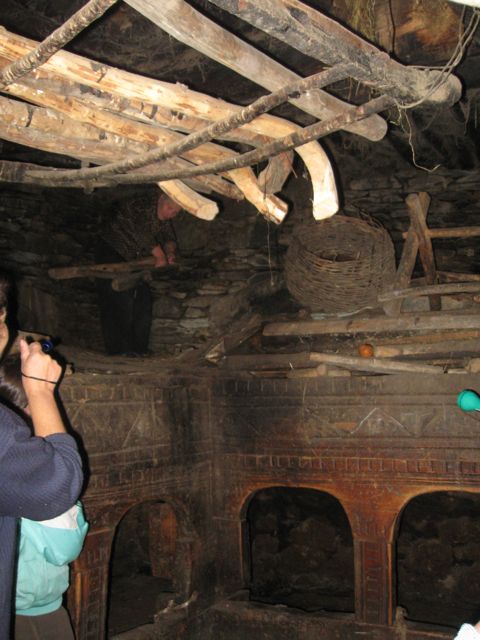
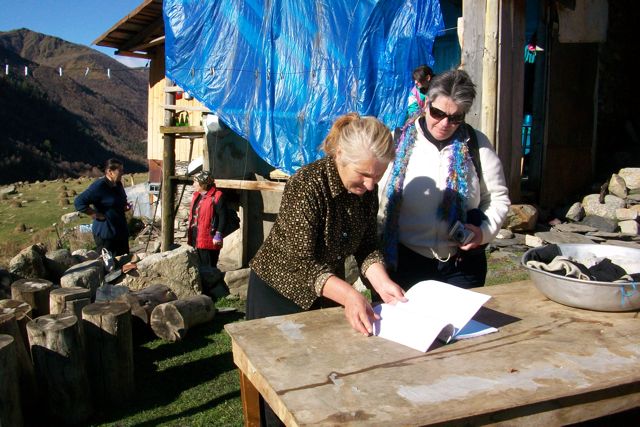
We were so impressed by the ladies knowledge and curiosity about their own family history. They are bringing up their brother's four children - both boys had neurological problems. Beth and I thought the eldest may have been autistic. The two girls both have eye problems, so the sisters have a great challenge, but were such stoic and delightful people. They gave us cheese, bread and rose hip jam to eat before we left. Everyone makes their own cheese, yoghurt, bread and jams.
Here the staples are potatoes which are currently being brought in from the fields along with the hay for the cattle. We watched this happening in the next village - a family with five young children were bringing the sacks from the fields - they had spent one week picking, and were now bringing them home to store. The pigs benefited from a spilled sack.
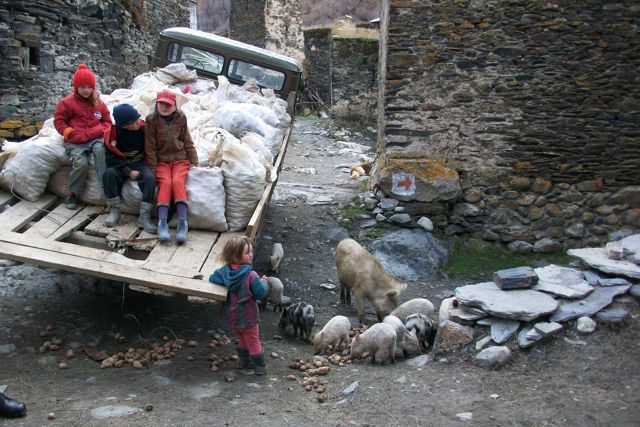
Haystacks being made with the hay brought back
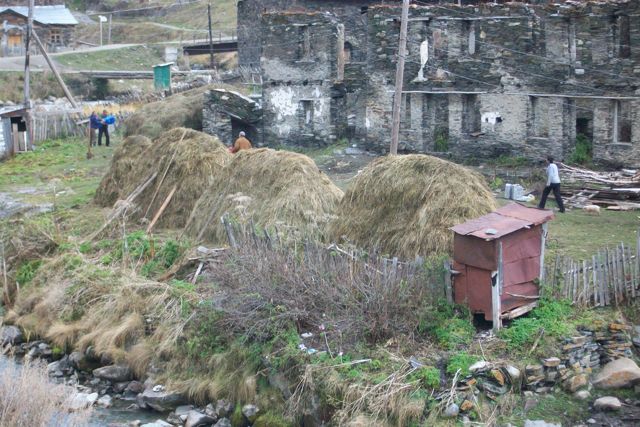
We wandered back up to our village for lunch.
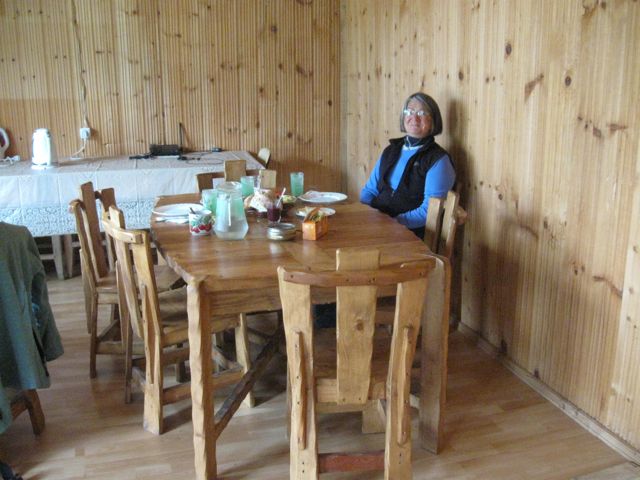
We then had time to find some local people who would sell us svan salt. This is a unique mixture for cooking of salt, wild cumin, coriander and garlic. By this time Taras had arrived to take us back to Mestia. At our guest house a party was gathering of border policemen - the border is only 18 kms away, and the brother at the guesthouse is one of these, so they were having a big gathering. They were all dressed in fatigues, with great looking binoculars and of course guns! The weather will soon be very inhospitable for anyone coming - the snow brings the animals and people indoors for many months - we have been so lucky to get here, and have fine weather.
The journey back to Mestia was three hours and we arrived just as dark had fallen. A warm welcome of food, and a bottle of wine we had bought in Mestia. This is not a wine growing area, so this will be our first real wine. Stephanie is toastmaster this evening!
Day 10 Friday 29th October Mestia
All night long it rained on our tin roof - were we pleased to have come back from Ushguli! There was notably more snow on the mountains at a lower level, and Taras said that for sure it would have snowed up in Ushguli.
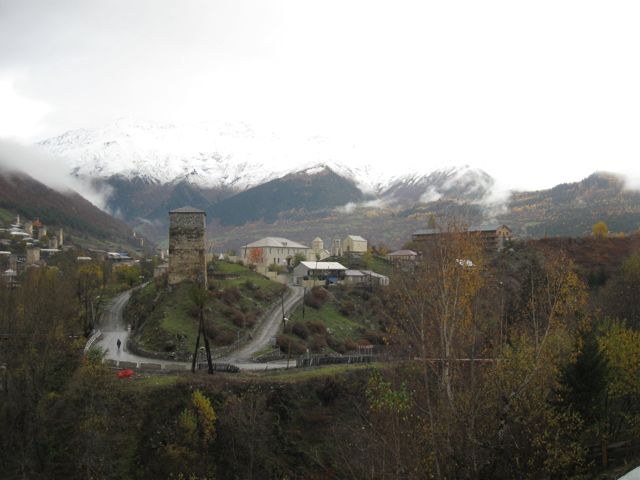
We decided to go to the History and Ethnography Museum of Mestia. It opens at 11 am, so I had time to begin inserting photos in the blog.
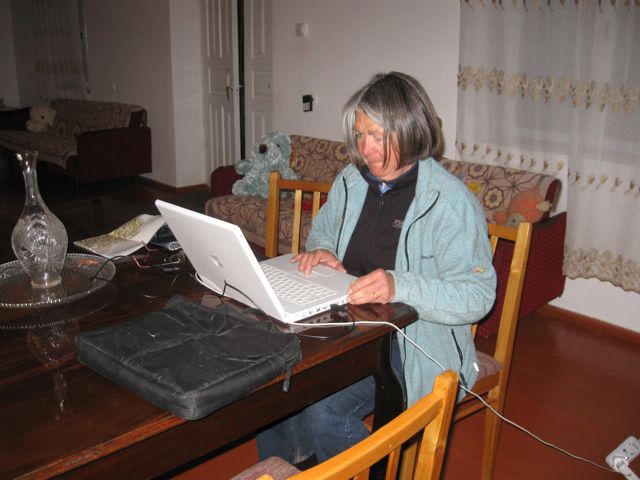
The museum is just below our guesthouse, and was many years in completion, starting in the Soviet times. The design itself is based on a cross, and it is modern and innovative - I particularly liked the swinging wooden door at the entrance.
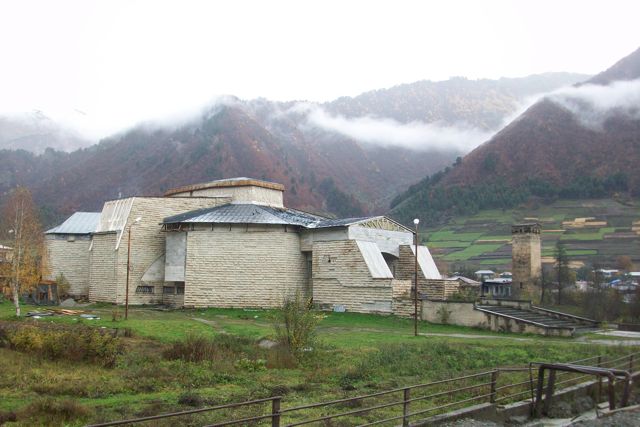
The woman curator was enthusiastic, and she and Marika got on very well, so that we learned a great deal about the svaneti treasures housed there. There were amazing bronze, iron and beaded works from 1st to third centuries BC - mostly found in graves, and we loved the ethnographical area, where we saw preserved many items and even a room like the ones we had actually seen in houses here in Mestia and in Ushguli. There was a fascinating room of illustrated manuscripts found in churches in svaneti, and another of icons and treasures, including gifts to Queen Tamar from Persia, and an old svan flag in the shape of a lion. The 12th century icon of the forty martyrs was quite amazing - things were well displayed and labelled in English. There was a set of photographs by the Italian Vittorio Sella, which were taken in 1890, and we were able to identify very similar scenes in Maseri and Ushguli today. Copies of frescoes, including the ones we had seen were on display, including the torture of Saint George, and the benefactor of the church we had seen. In fact some of these copies were done by the artist we had met in Mestia.
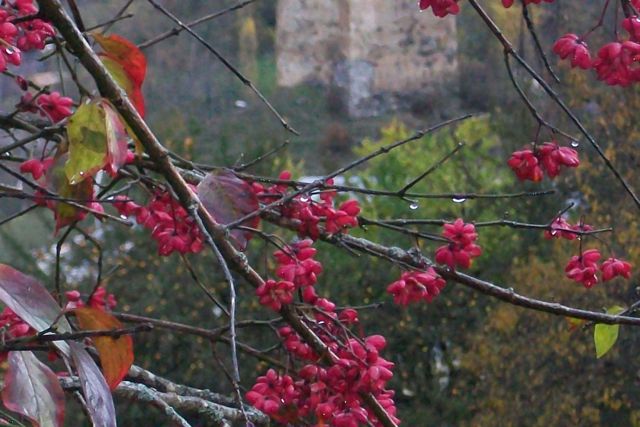
The spindle bush outside our guesthouse
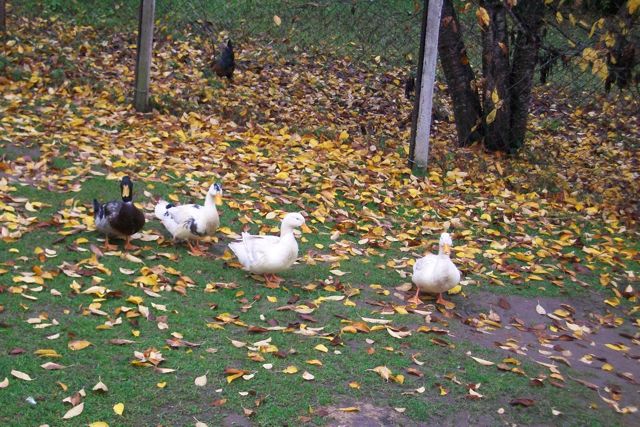
The house ducks were enjoying the rain
The rain eased for a brief time while we walked back up to the guesthouse for lunch at 3 pm, but returned, so the afternoon was spent reading or working on the blog.
Day 11 Saturday 30th October Mestia to Tbilisi
A very long day of travelling in the rain! We left Mestia at 8:15 am and arrived in Tbilisi at 8:00 pm. Just as we were leaving Mestia, we new we had been here long enough to know the locals as we passed and waved to the curator of the museum just bringing in her cow for milking! The first part of the journey Taras drove us down the road to Mestia - the road was quite difficult with even more mud and landslides, so it took us four and a half hours. Zura had driven all the way from Tbilisi (320kms) to meet us in Zugdidi, and in the pouring rain we swapped luggage and immediately set off on the journey back at 1:00pm.
The traffic was not too bad, some large trucks from Turkey. I liked the signs which said how far it was to distant lands, including Baku and Teheran which was 1230 kms! We stopped around 3pm for lunch in a Ukrainian restaurant in Kutaisi and met a young man who had just had his first son "Father - son" he kept saying as he was out celebrating with his mates! On up the mountains which divide West and East Georgia, and we saw again the mushrooms, pottery and bread for sale. The last 50 kms were on motorway (the rest had been on two lane road), so we arrived back. We staggered out of the car, the lift wasn't working, but Zura helped us up to the fourth floor with our bags and we collapsed back into Beth's apartment.
Day 12 Sunday 31st October Tbilisi
We were up early, trying to get internet connections in Beth's flat over 6 am coffee. A couple of loads of washing later, we went out to brunch at a local restaurant that had free Wi-Fi. I uploaded the blog and all the pictures over Egg Florentine and Pomegranate juice! We did a big shop at Beth's local supermarket and staggered home like pack horses. We then set off for downtown after a walk towards Vake Park, and took a number 61 bus to the stop nearest the Raddison Hotel. We had fantastic views of the city from the 18th floor.
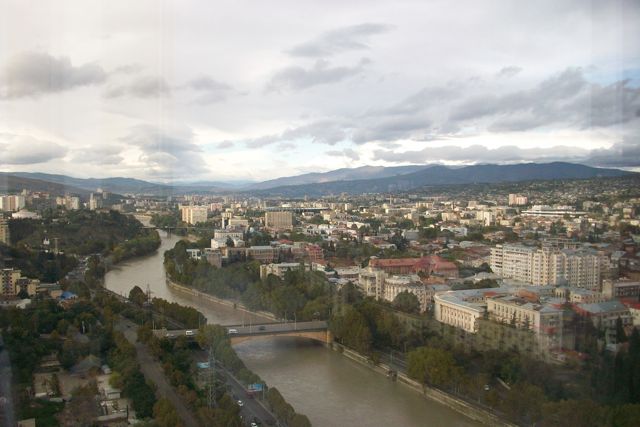
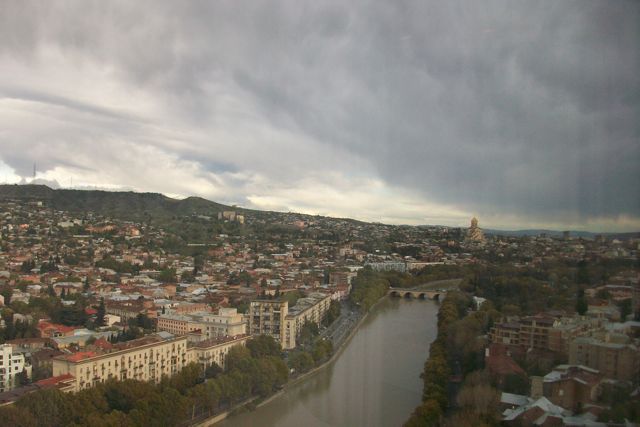
We ourselves were having the most wonderful relaxation culminating in a Georgian massage.
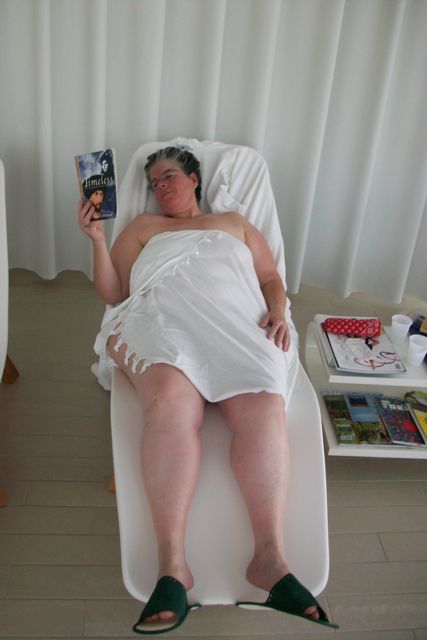
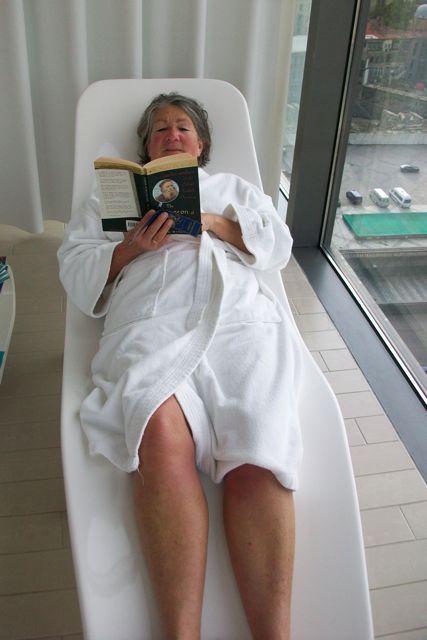
This was such a great way to recover from our 12 hour journey yesterday, and we were well and truly relaxed for our Georgian dumpling meal. There were dumplings stuffed with meat and coriander and mushrooms stuffed with cheese and baked in the oven.
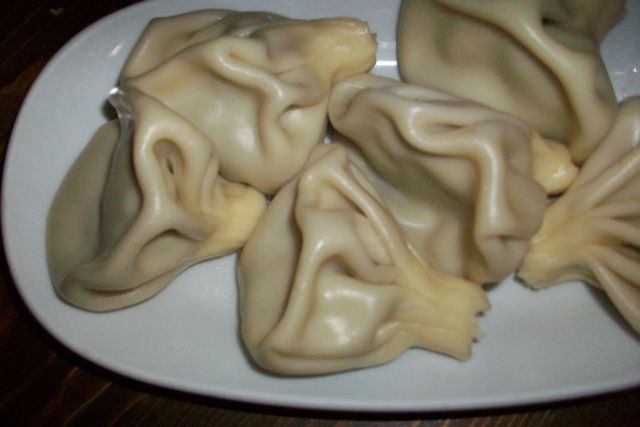
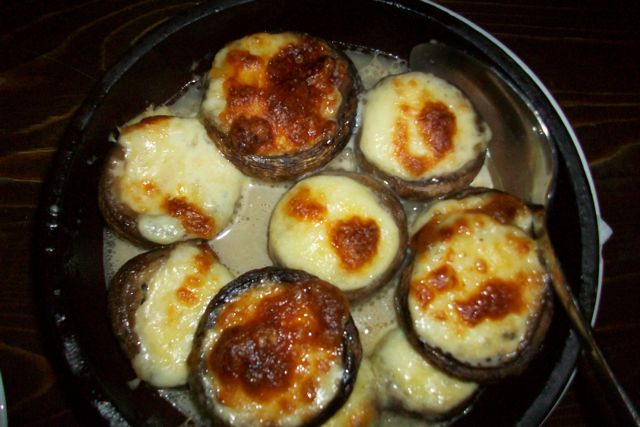
Taxi back to Beths for a final sort of washing, skype to Beths parents in Connecticut, and relax for Beth's last evening before she gets back to work tomorrow.
Day 13 Monday 1st November White Rabbits in Tbilisi
Assimilation day! Khinkali is the name of the spicy meat dumplings, another dish I have enjoyed is Badrijani Nigvzit - aubergine in walnut paste, but of course khachapura (cheese pie), which appears at every meal, is a favourite. The Feast is called a supra, and the toastmaster a tamada ( I would like to introduce this tradition at Marigold Cottage feasts, so watch out). The person elected after the tamada is alaverde. The words I have mastered are few and far between as Beth (and Marika) have been my voice, but gmadalobt (thank you), gamarjobat (hello) and gaumarjos (cheers) seem to come out at the right time.
I went out exploring, and found a neighbourhood up a hillside where I might live if I stayed in Tbilisi - the countryside would be perfect for Hashers, and as I later discovered when I met two HHH members, this is so - the hills are very accessible all around the city. I bought Kachapuri for lunch from a hole in the wall, and later went to the internet cafe to catch up with e-mails. Beth got home around 6:30 pm, and her singing group began arriving almost immediately. She had ordered pizza and everyone had wine and sat with their voices - first, second and bass. I sat with the seconds and joined in as best I could. The polyphonic Georgian singing is very emotional and somehow draws one in. We learned one new song, and then revisited a couple of old ones, Beth did a wonderful solo in the last song we sang. I can see why she loves it so, and her voice really suits the music.
Stephanie joins the Georgian singing group!
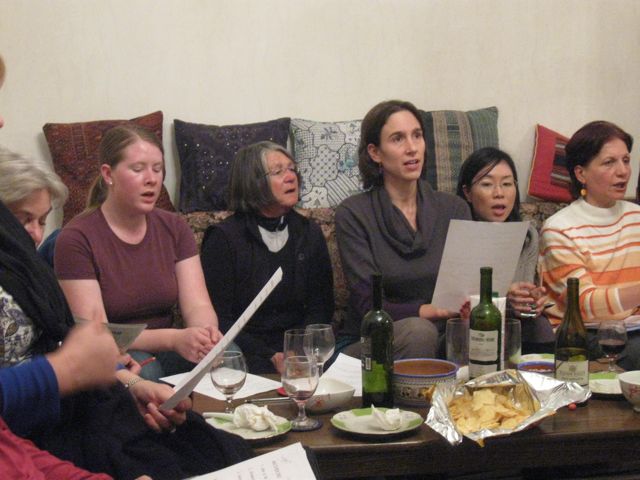
Day 14 Tuesday 2nd November Tbilisi
We both got up really early, and had breakfast together, leaving at 8 am, Beth to go to school and me on an outing! Zura, our driver from the trip to Zugdidi and back , took me to Davit Gareja right on the Azerbaijan border to the south-east of Tbilisi. This is the most amazing place, a monastery which was founded by Davit Gareja who came to spread christianity in the 6th century. We left Tbilisi and crossed into the Khaketi region which is the main wine area of Georgia, but we turned south and headed into the desert and high mountains . Here we saw nothing but occasional herds of cattle and sheep on a lunar type landscape.
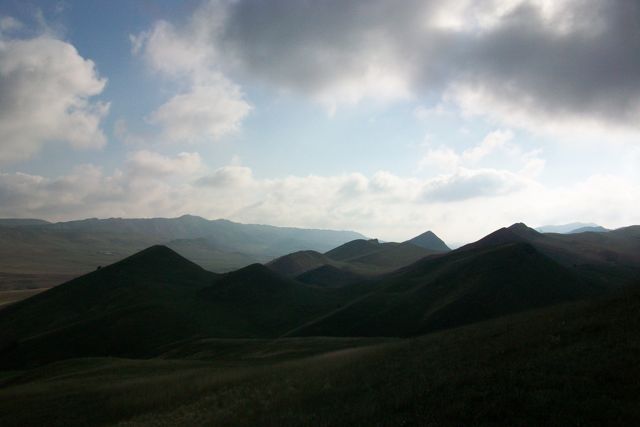
The road became dirt and finally dead ended at the Lara monastery, which is still in use today. There were from the 6th century monasteries all over the area, but this is the only one still used. The monks live in caves and are ascetic monks, so you are not allowed into this first monastery.
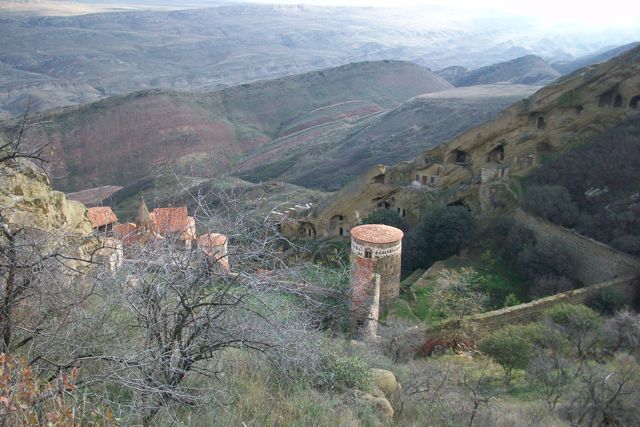
Zura declined to join me on the hike as he thought it would be too difficult for him! Indeed it was quite a steep climb, and a little slippery, especially on the steep descent at the end. I loved every minute of it. The silence was overwhelming, just bird noises - I saw more birds today than in the whole time in Svaneti.
I climbed steeply above this monastery to a ridge, and walked on the Azerbaijani side along a cliff littered with the caves of the Udabno (meaning desert) Monastery.
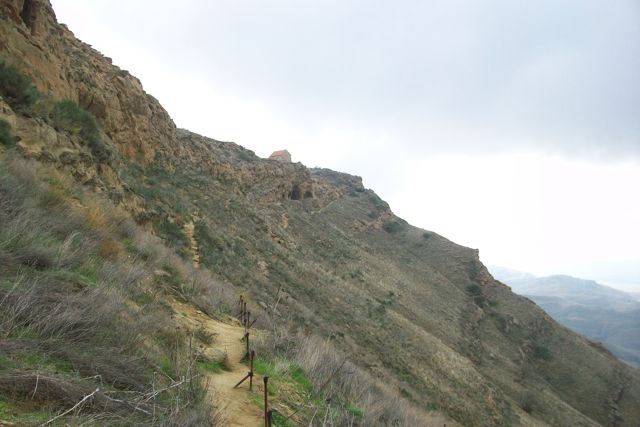
Some of the caves were churches, chapels or just cells, and several had frescoes dating from the 10th to 13th century.
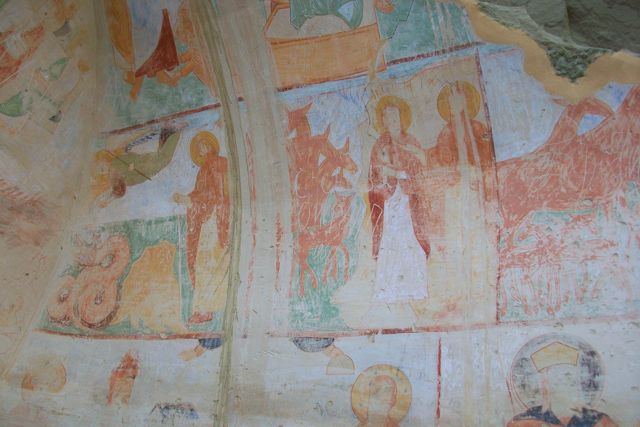
I loved it as I walked along the narrow path popping in and out of the caves and overlooking Azerbaijan.
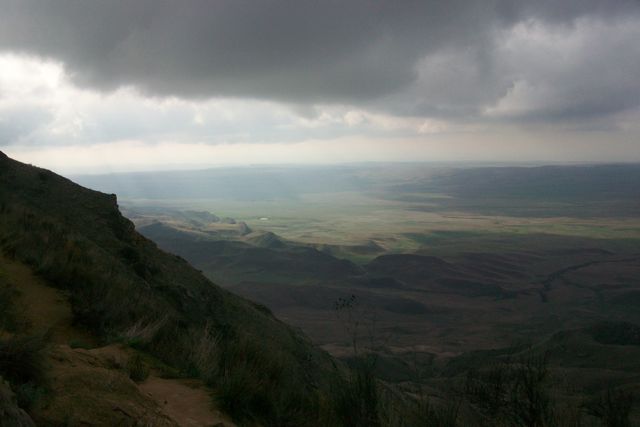
The monastery ended at a chapel at the end of the ridge, from where there was a steep descent back to the other monastery.
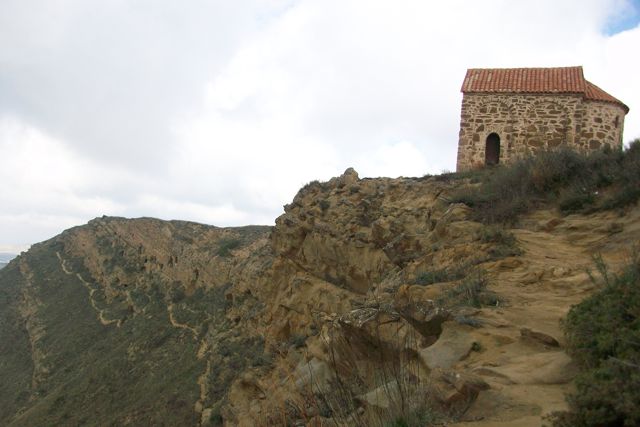
Absolutely brilliant, I loved every minute, though I was on the lookout for the venomous Lebitina Vipera snake which lives in this area!
We drove back to Tbilisi through the desert landscape for about 22kms before hitting more civilised roads, though in this area they use donkey carts more, and of course the cattle wander across all the roads. At one point today we had a young horse come galloping out of the walnut grove - we fortunately managed to avoid this!
This evening when Beth got home we went out to a very traditional Georgian restaurant down by the river. In summer you can sit out on the terrace overlooking the water, but too cold for that tonight! The interior decor was very traditional
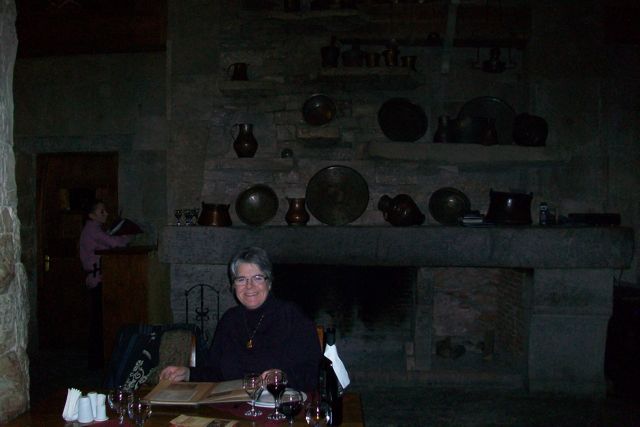
The speciality is shashlik, and we chose pork in pomegranate juice, mixed vegetables and chicken in a pot - it was all very tasty. The highlight was a group of musicians who performed traditional music and songs, some of course which Beth knew.
Day 15 Wednesday 3 November Tbilisi
Another grand and glorious day weather wise, cool but clear blue skies and sunshine. I took the bus all the way downtown to under the city walls, and re-visited a little of Old Tbilisi with its balconies and pipes dropping water onto the streets - I was glad it wasn't raining!
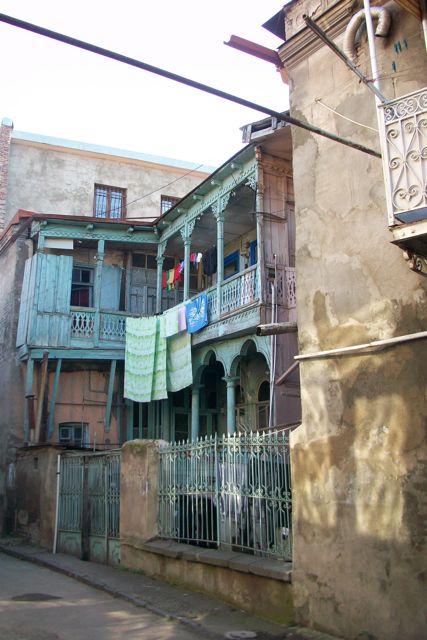
I managed to capture one or two of the statues in that area
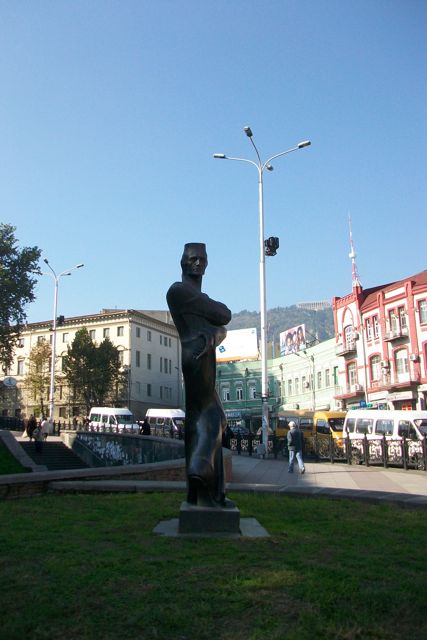
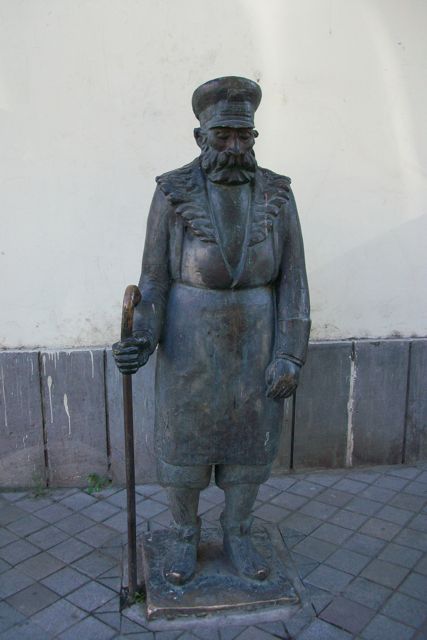
I then crossed the Metekhi Bridge to the East side of the River Mtkvari, and climbed up to the Metekhi Church for a panoramic view of Old Tbilisi

I could also see the controversial new Presidential Palace
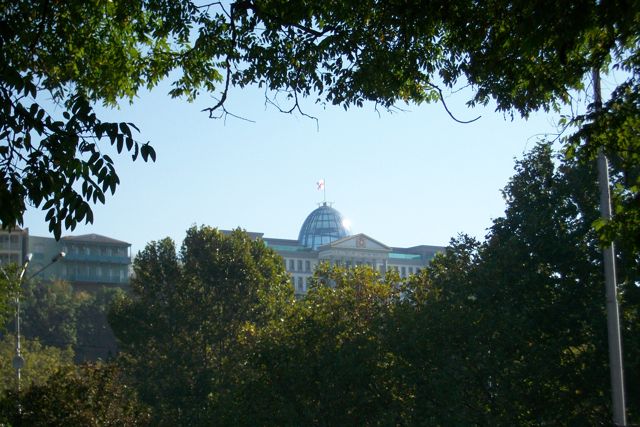
I was in the Avlabari area of the city, which was the old Armenian quarter. There were again narrow streets with old houses, and lots of small shops selling bread and food, but the place I walked to was very new and opulent. this was the Tsminda Sameba (Holy Trinity) Cathedral, consecrated in 2004, and a huge symbol of Georgia's post Soviet religious revival.
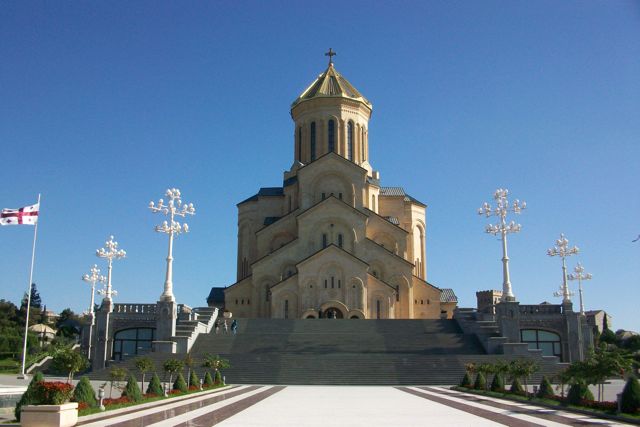
The marble, the black and white swans on a pond, the flower beds and entrance areas I found very restful and attractive, and a peaceful place to sit and read overlooking the city on the west side.
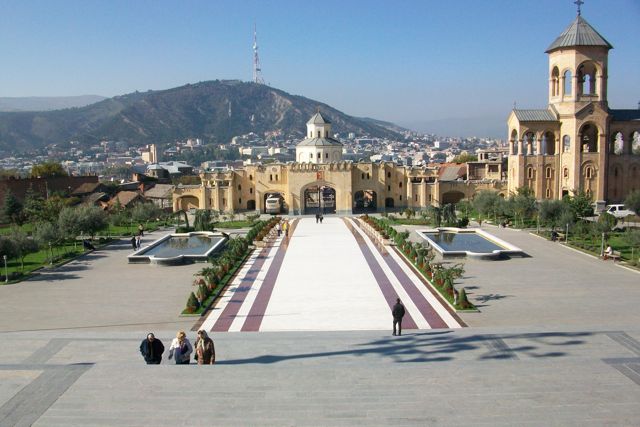
All over the city there is rebuilding and construction work, and if the renovations and new builds are anything to go by, in a few years Tbilisi will be even more attractive. The trees and seating areas everywhere make it a very relaxing city to be in, and the traffic and buses work very well.
A tired Beth arrived home at 6:30, so we ate locally and tried to work on her home internet which is causing problems.
Day 16 Thursday 4th November Tbilisi
Today I had an excellent outing with Zura into East Georgia and the Kakheta Province of Georgia - wine country! The town we headed for was about two hours drive from here perched on the edge of mountains overlooking the Alazari valley, and the snow-capped Caucasus beyond.
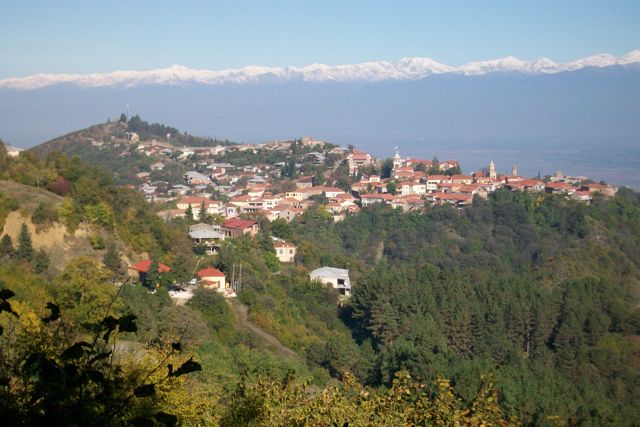
We arrived about 11am and I had a good two hours to explore this 18th century town of Sighnaghi. 5t has recently been renovated as a tourist attraction, and was very pleasing on all accounts. I first headed for the walls, which are 4.5 kms long, and not all parts are accessible, but I did a good job of climbing towers and getting the views.
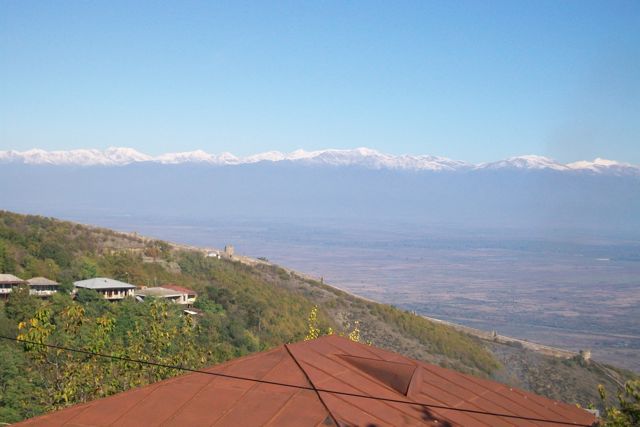
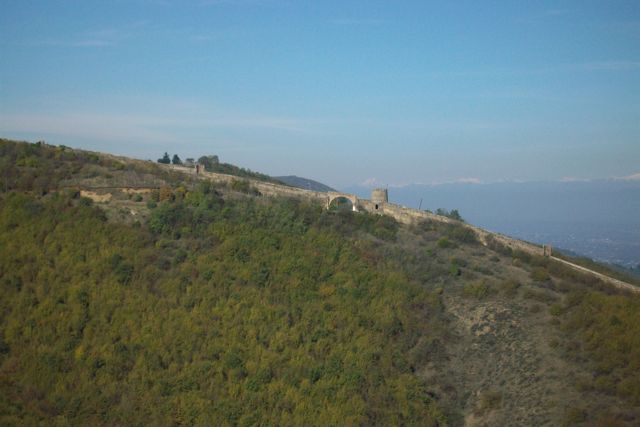
There were also many churches - attractive in their bricks and towers.
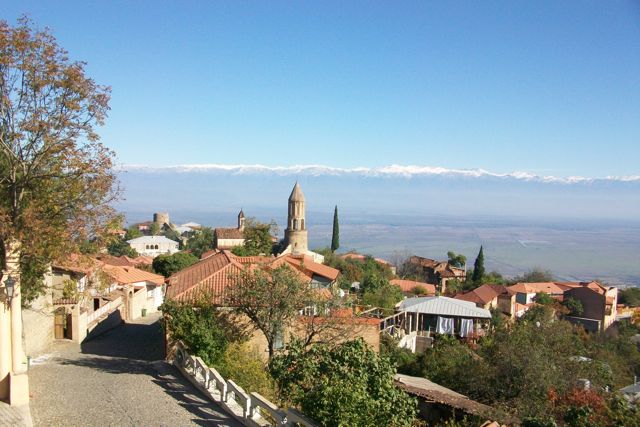
The most charming feature for me were the wooden lacy balconies and tiled roofs, which have been restored very sympathetically
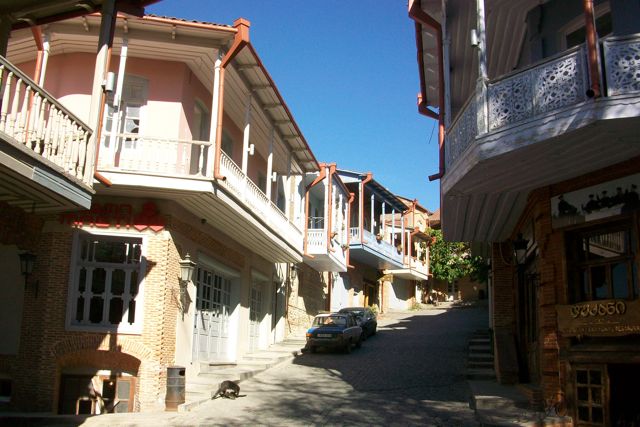
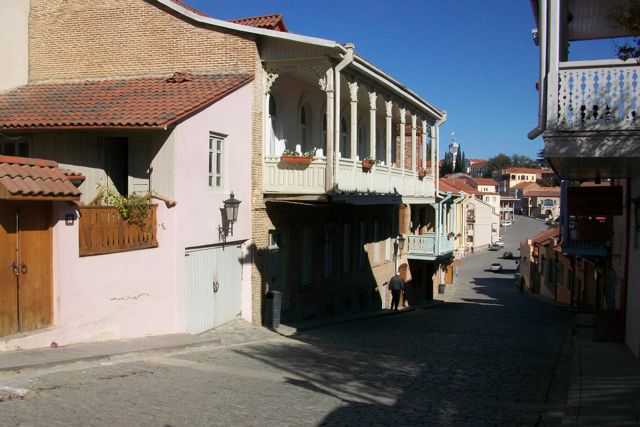
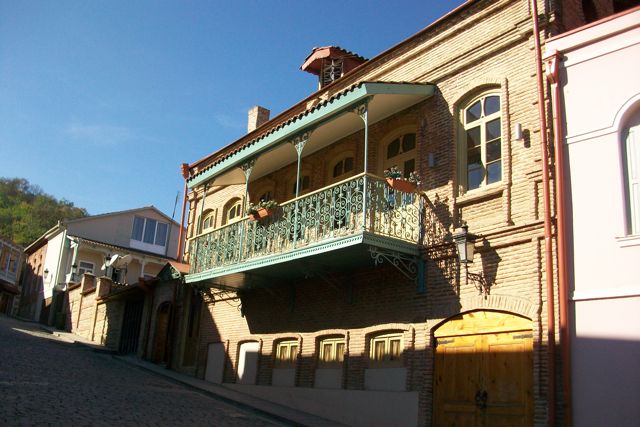
The houses were originally built as it became a big trading centre for local artisans in the 18th and 19th centuries. Now the wine industry will draw tourism to the area, and I can imagine there may be more evidence of this in a few years time. There is a foreigner, John Wurdeman, who has set up a winery here, and there are signs for guest houses and hotels, but unlike other countries, no tea shops and coffee houses, though there were some nice squares and fountains where one could sit.
Zura was asleep in the car when I returned, and we set off back, stopping first at the side of the road for shashlyk, pork shish kebab, which was delicious. Meat was being sold all along the side of the road in this region - apparently it is quite famous for pork, and farmers slaughter and hang up for passers by. There were also cheese makers, so we stopped to buy cheese (sheep and cows) I found some of it very salty.
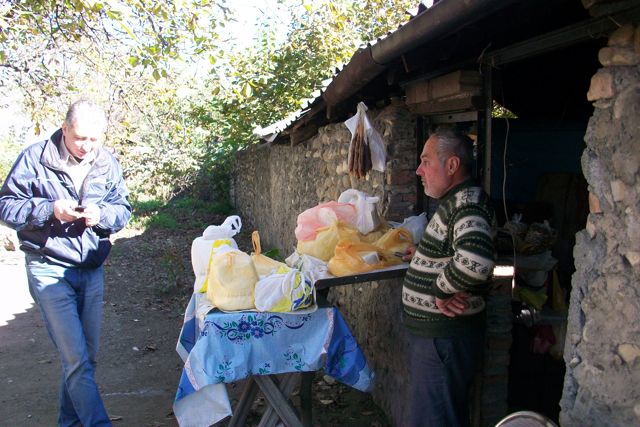
Back in Tbilisi for 3:30 pm, I went out shopping to the green grocer just around the corner as I am making a stir fry for Beth tonight before she goes out for her Georgian singing mini group.
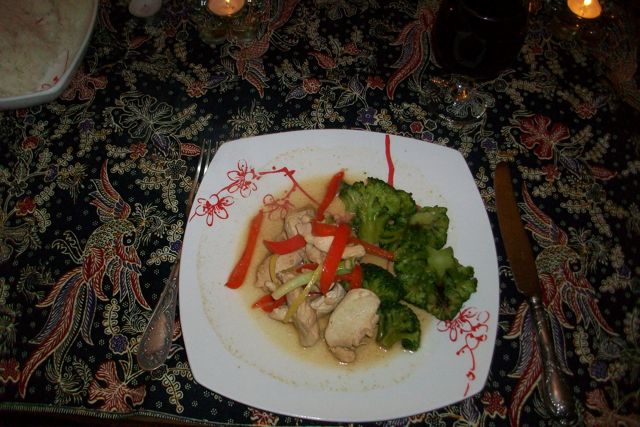
While Beth was out Giorgio came to try and sort out her Wi-Fi and internet problems, which he did very quickly - we are all Apple Mac fans, so I learned from watching him sort Beth's computer out as well. Early night for me, reading my sixth book since arrival.
Day 17 Friday 5th November - Tbilisi
A leisurely morning packing, hair wash and tidying before setting out for a walk in Vake Park, and then heading up the hill to Beth's school in the suburbs. I found it no problem, but can understand why Beth does not do the 45 minute walk everyday.
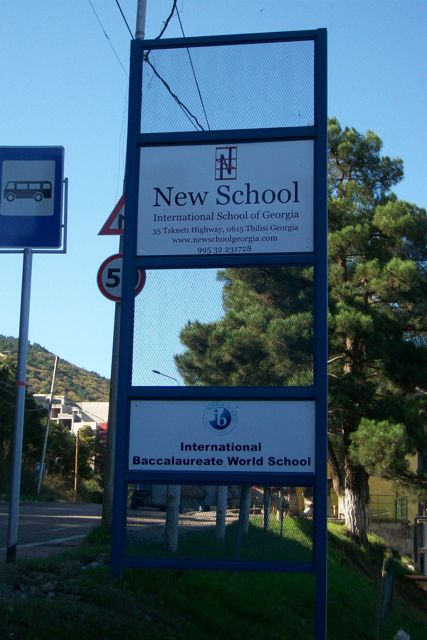
I was greeted at the school by the owner and Director, Marina. She was a very personable lady, who kindly showed me around and had a chat. She and her husband bought this factory ten years ago and converted it into a small Georgian elementary school. Four years ago she added the English side and employed Beth as Principal, and to set up the PYP IB program. Since then she has expanded into Middle school, and now they have the first year of the Diploma program in High School. Marina is a visionary and dynamic person, and I was drawn to her immediately. She asked my advice on her gardens, and I will send details of bulb and seed catalogues. Beth then joined us and took me for lunch in the canteen, and showed me round the swimming pool, library and classrooms - cleverly arranged so that the Georgian and English classrooms for a particular grade are next door to one another.
While Beth worked in her office, I sat outside and read a book in the play area - these areas are all very pleasant as there are so many trees and plants around. Here is Beth in her office, so at home in her role.
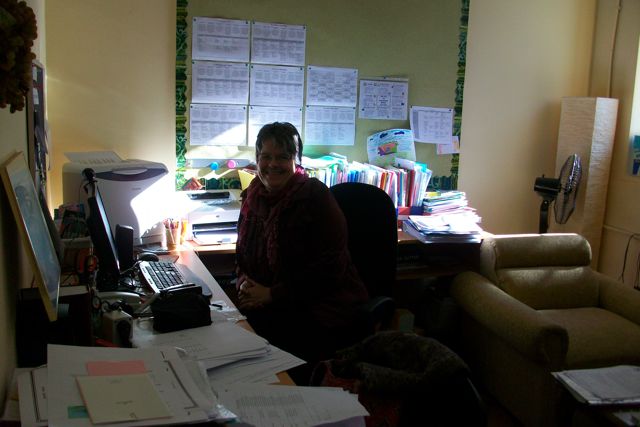
We left the school just after 4:30 and after a brief stop at the apartment, we headed downtown to the Abanotubani area - in other words the sulphur baths, which I had photographed from the outside area. We actually did a reconnoitre of all the baths, being shown rooms and getting prices before we finally chose The Royal Baths.
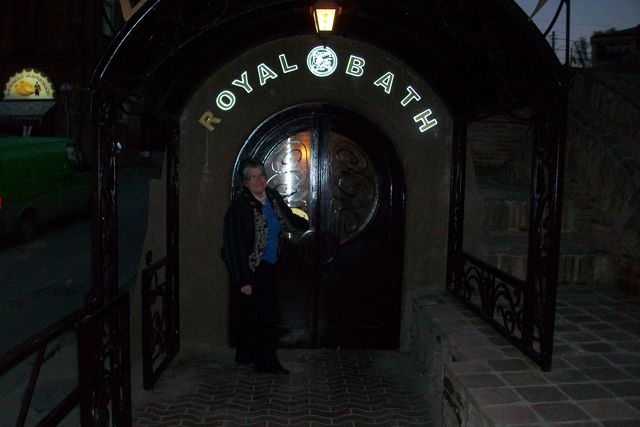
We took a room for an hour and had a wonderful relaxing soak, then a rest and then back in again
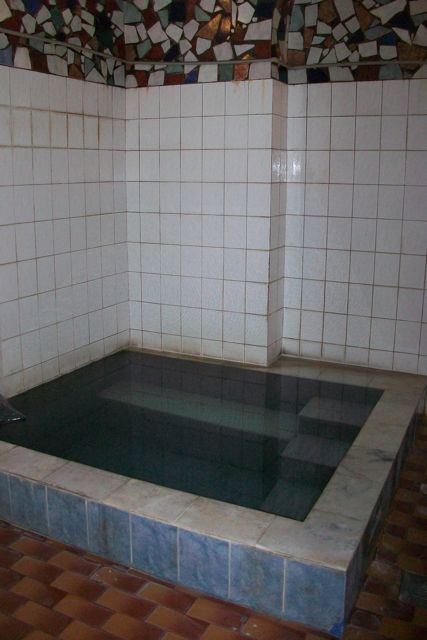
Our skin felt wonderful afterwards, and you can see why the likes of Alexander Dumas and Pushkin loved this area.
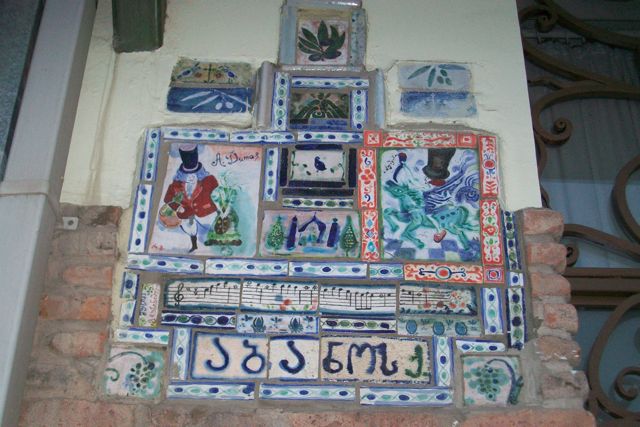
These were original tiles on a house opposite.
We felt very relaxed and wandered to another of Beth's traditional restaurants for a 'Last Supper' of Georgian food which I have so enjoyed. This evening we had a lamb dish to accompany the aubergine and salad below.
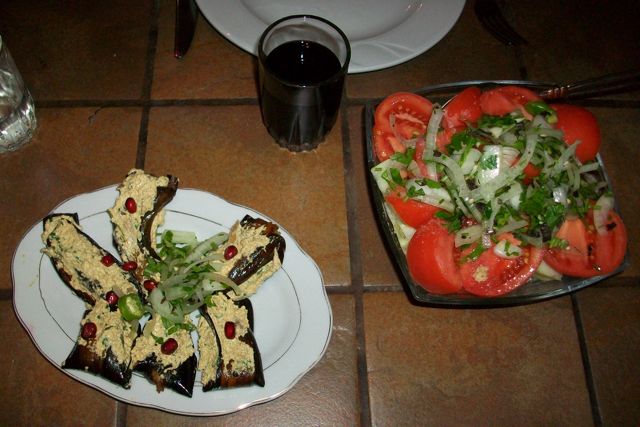
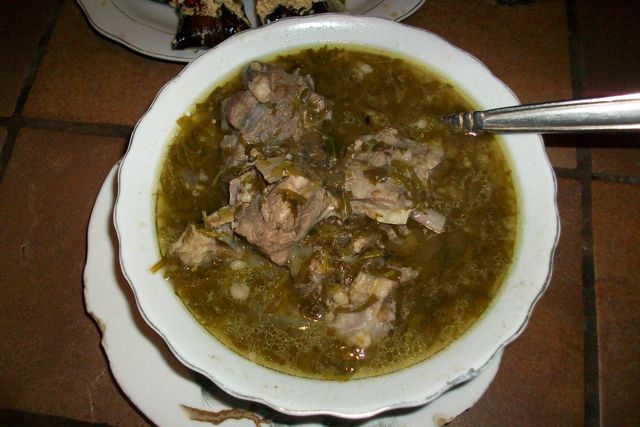
We got 'home' around 9:30 pm as an early night was called for because of getting up at 3:45 am. We managed to successfully transfer photos between computers before packing up.
Day 17 Saturday 6th November - Sutton-on-Sea
How strange to write the latter, but indeed, the holiday has come to an end, and bless her, Beth got me up with coffee and came with me to the airport to see me off. I never cease to be amazed that you don't need a ticket, and can just turn up with your passport. In Amsterdam I again transferred through the computer with just my passport, and by 10 am UK time I was in Humberside being met by John and Maylee.
What a brilliant holiday and adventure with Beth - I feel I have been taken out of myself and reinvigorated - it has been wonderful.
THANK YOU BETH